Wicked Task Manager
With Drupal
Presented By Kathryn Carruthers
Who am I
I'm a freelance webmaster who's worked with labour organizations and nonprofits for most of my career.
I've been making websites since the mid-90s, and using Drupal for most of them for the past 8 years.
What are we doing
Building the single greatest task manager you've ever used!
Or at least the best one you can build in a day.
Agenda
- Get setup with a Drupal site
- Think about what makes a great task manager
- Create some content
- Build a new content type
- Add new functionality (i.e. install modules)
- Build a list of tasks (i.e. Views)
- Add actions to your task list
- Improve the task list UI
- Take home assignments (advanced features)
Create Account
Go to getpantheon.com and create your account.
Select a name for your site.
(ex: my-awesome-site)
Your site name has to be unique though (they'll all be living on the same server).


And we wait...

Text
Text
Text
CHOOSE YOUR DRUPAL
Install Drupal 7
Choose Drupal 7 as your site install type.
Then visit your site to install it.
Choose "Standard" install.
Fill in all the required fields as necessary.
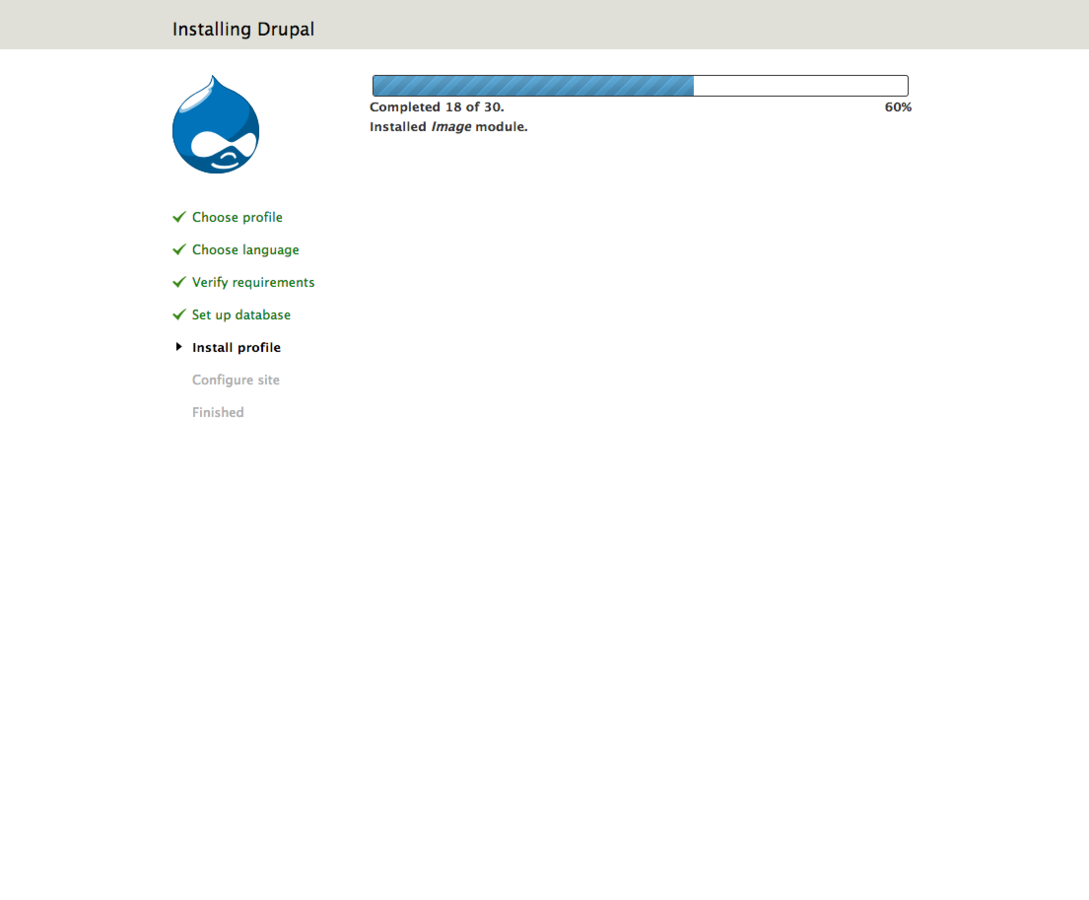
Victory!
Yes there's a spelling mistake...
Step 1
What is A
Task
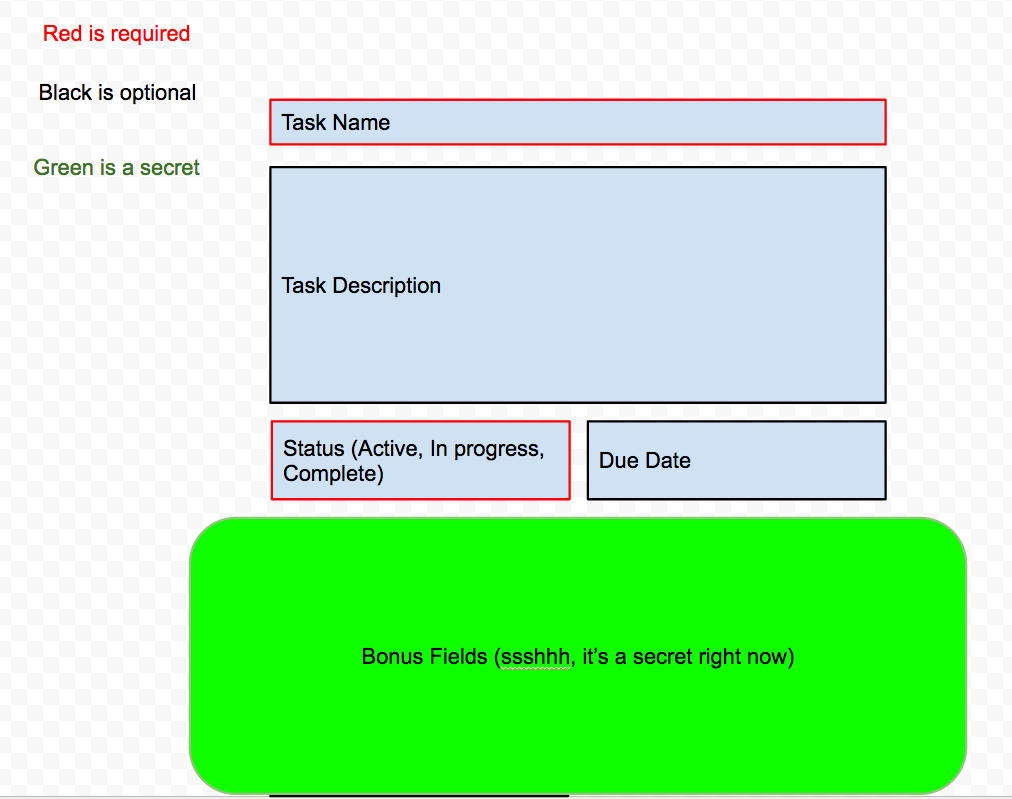
questions you should ask yourself
- Does Drupal Core do this?
- If not, can I configure it to do this?
- If not, can I download a module?
- Well, time to write code...
Check Drupal Core
Create an article
Use the Admin Toolbar at the top of the page.
Click on "Content", then "Add Content", then "Add Article".
Let's see if our tasks work well as articles.
What's missing
- Well I've got my tasks in a list.
- I can't make each one as done.
- I can't really assign a due date to them individually.
- I can comment.
- I can categorize.
- I can't mark one as in progress.
- Still better to use pen/paper
Ok, can I configure Drupal core to do this?
content types
Default container for storing content in Drupal.
You can add your own content types to fit your needs.
Add a "Task" content type.
Click on "Structure" then "Content Types"
Add a Content Type
Here you can see the current list of content types.
Add one called "Task"
Don't forget to set your publishing options,
and your comment settings,
and turn off menus (we'll deal with this later).
Fields
Content types are made up of "fields". Fields are what make one content type unique compared to one another.
When you create a new content type you get the "Title" and "Body" fields by default.
Let's customize the "Body" field settings.
Field Settings
Field settings are broken into two parts; instance settings and global settings.
Instance settings are the settings specific to this field and this content type.
Changing those settings only affect this field on this content type.
Field Settings
Global field settings affect the field on every content type they're used.
For example, "Article" and "Task" types both use the "Body" field.
If you change the settings in "Task", you'll change the settings for "Article" as well.
Be careful changing global settings.
More About Fields
Of all the things you do with Drupal, you'll more than likely spend your time adding / customizing / removing fields. Be sure you grasp how they work.
It's important.
Everything else we do today will use these fields in one way or another.
Try it out
Create a Task
Click on "Content" then "Add Content". You'll see the "Add Task" option. Fill in the form.
What's Different from Article
What's Missing from our Design?
What do we know about the task status?
- List of options
- Text values
- Mandatory
Field Types
A "Field Type" defines the kind of information you want to store in the field. Drupal has field types for:
- Text
- Numbers
- Decimals
- Long text
- etc...
Field Widgets
A "Field Widget" is the tool which users will use to enter this data.
For example, if you have a list of stuff, you can use the "select list" widget.
Different field types have different widget options.
List (Text)
Since we're storing a list of text values, we'll use the "List (text)" field type.
Users can use the "Select list" widget to make their selection.
Other options include radio buttons and checkboxes.
Name your field "Status".
Global Field Settings
When you add a new field, you'll always setup the "global" field settings first.
Use the options below as your "Allowed values list"
active|Active
complete|CompleteInstance Settings
Next we configure the settings specific to this field on this content type.
Set your help text, default value and required settings.
Achievement Unlocked
Add a New Field
Retrospective
- Did Drupal let me add what I wanted to?
- How was the experience?
- Can we do better?
Yes
We
Can
Modules
What's a module?
Similar to how fields let you customize content types, modules let you customize Drupal itself.
What can they do?
They can do anything!
Modules are what make Drupal great for a lot of different uses.
Where to find modules?
Options Element
Adding options to our select list was kind of ugly.
Options element module makes it nicer!
Let's download / install the module.
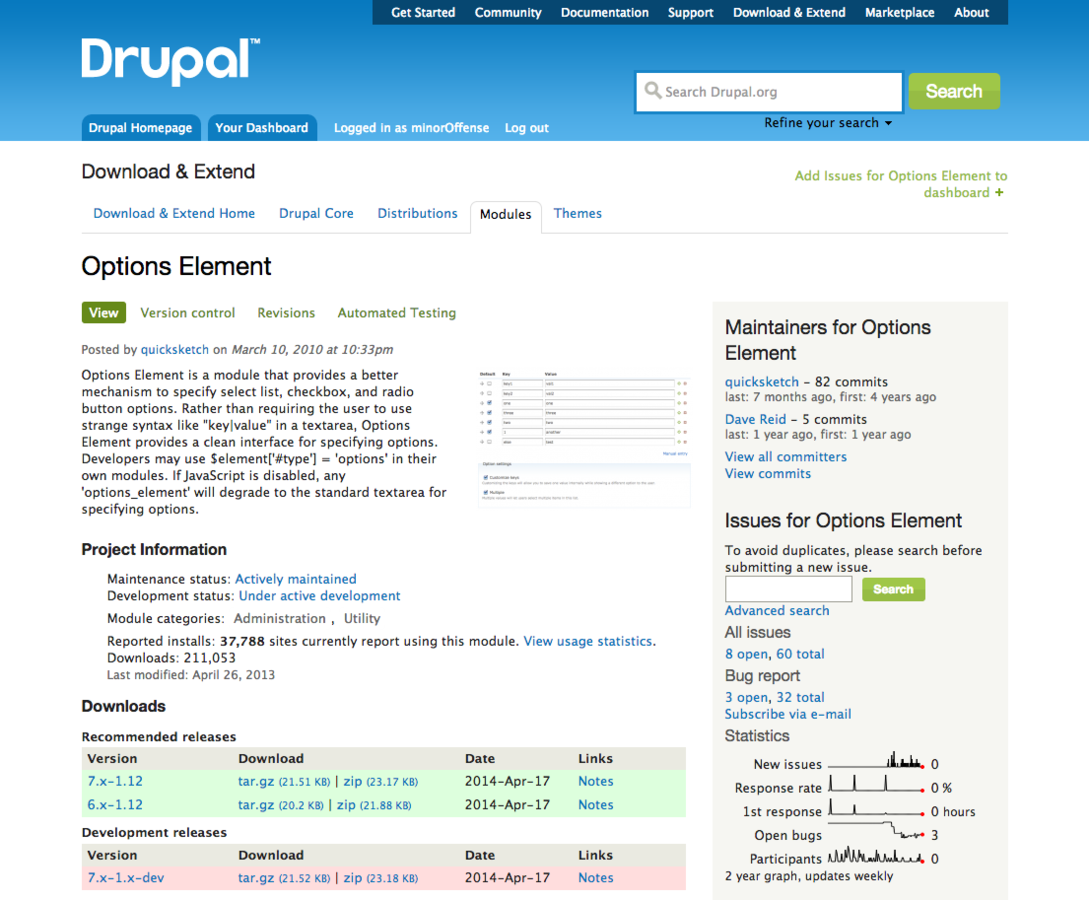
https://www.drupal.org/project/options_element
Drupal Project Pages
- Description of the module
- How many people are using it
- Versioned releases
What are Project Releases?
Themes, modules and install profiles are all different kinds of projects on Drupal.org.
Each of them let you customize Drupal in a different way.
A "release" is a particular version of that project. Typically you want to stick with "Recommended" releases (the green ones).
If you want the bleeding edge, you can use dev releases. But be warned, these can break your site...
Installing Modules
Adding new modules to your site has three steps.
- Download the module
- Install/enable the module
- Configure the module
Where do I put Modules?
Normally, you put them in "sites/all/modules" on the server.
Pantheon let's you upload them through the UI and puts them in place automatically!
Module Admin
Click on the "Modules" option in the admin toolbar.
Click on "Install new module"
Copy the link from Drupal.org for your release and paste it into the box.
Click "Install"
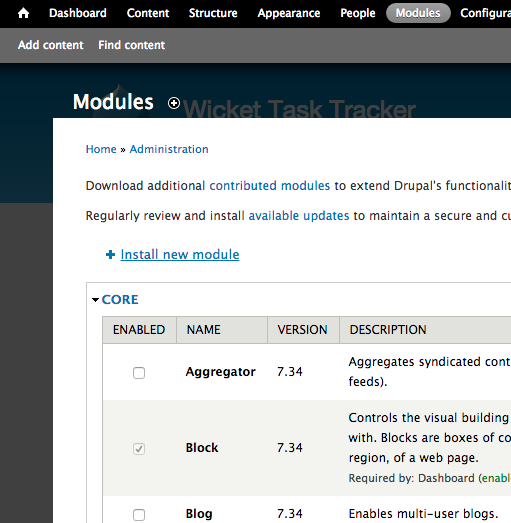
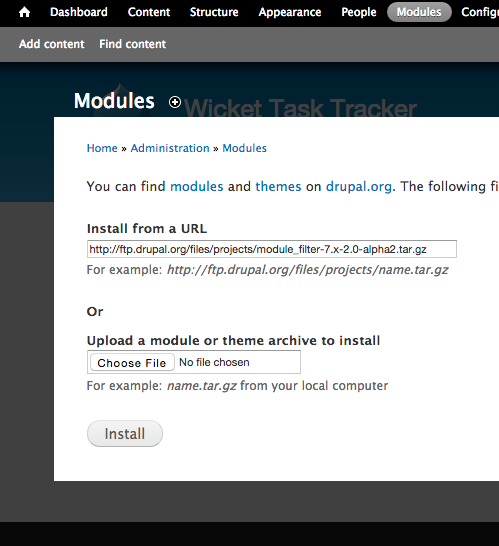
Add another Module
While we're here, let's add a module to make managing modules better! (whoa...)
Google "drupal module filter"
Find the recommended release link and add the module to your site.
Click enable and configure.
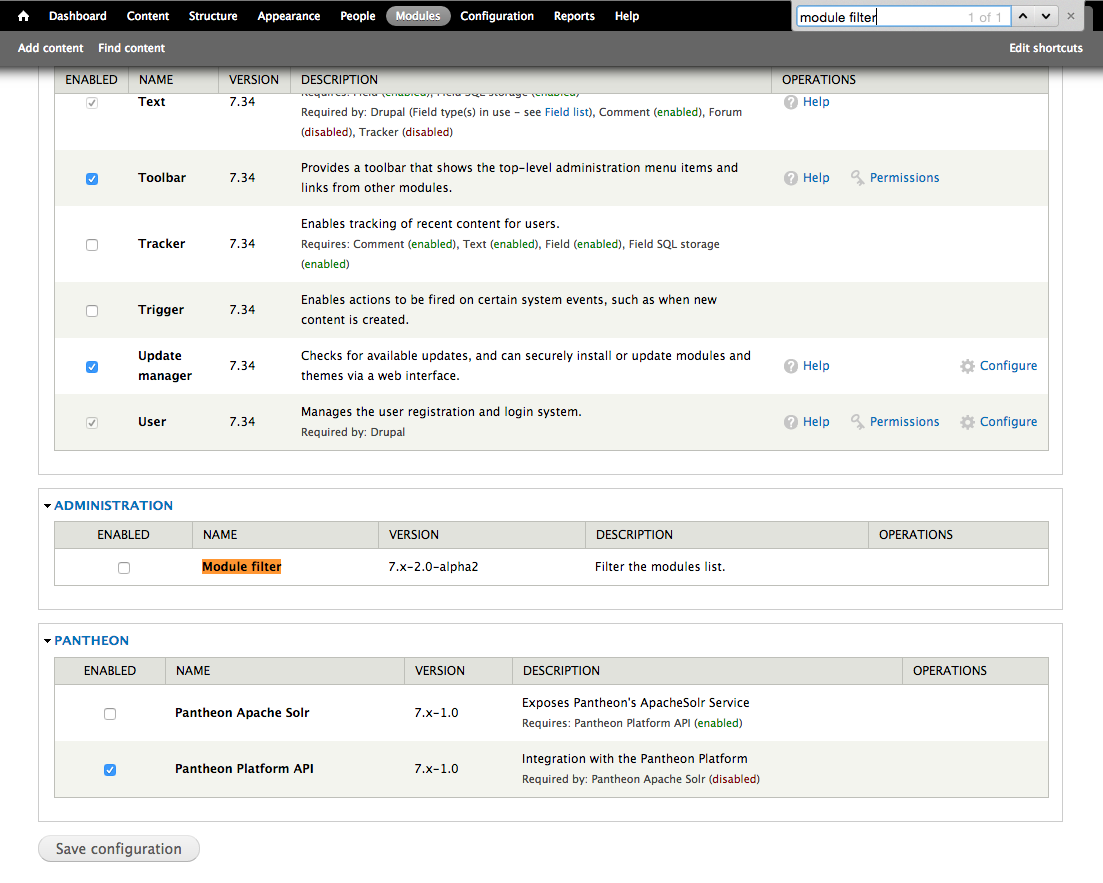
Find "Module Filter"
Find the "Module Filter" module in the list on the page (use CTRL-F or CMD-F)
Check the box next to it.
Click "Save Configuration"

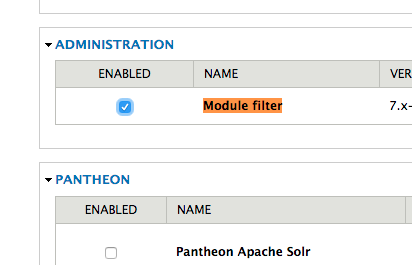
Bam! Better Module Management
You'll see the list of modules is better organized and has a filtering option.
I install this on all my Drupal sites. And you should too.
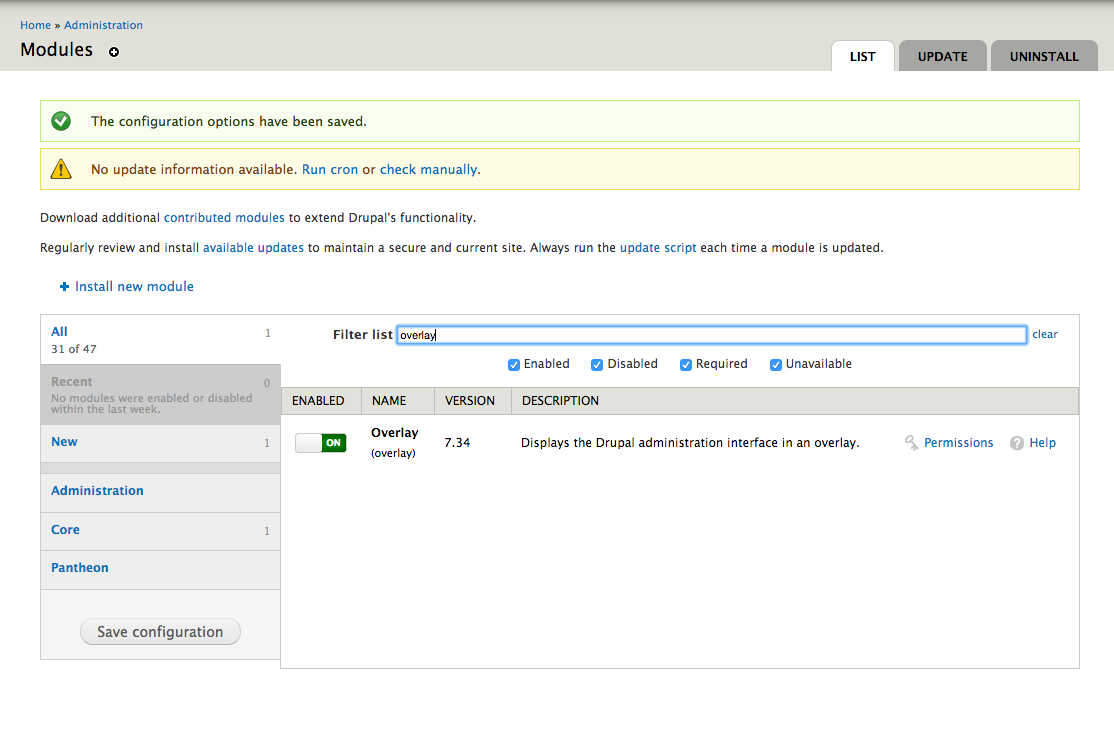
Enable Options Element
Find and enable the options element module.
Go back and Edit your Status FIeld
Click on "Structure", then "Content Types". Then "Manage Fields" next to "Task".
Then click on "Edit" next to the "Status" field.
Much better...
Now you can add new options, drag them around, set the default value, all in one simple interface.
While you're here, add a status state called "In Progress"
(set the key to "inprogress")
Achievement Unlocked
Installed Modules
Next Up
Due Date
WHAT DO WE KNOW ABOUT THE Due Date?
- Store date data
- Not required
- Only set future dates
- Only one date allowed
Manage Fields
Go back to manage fields for your Task node type.
Look for a Date field type.
Is there one? If not, what do we do?
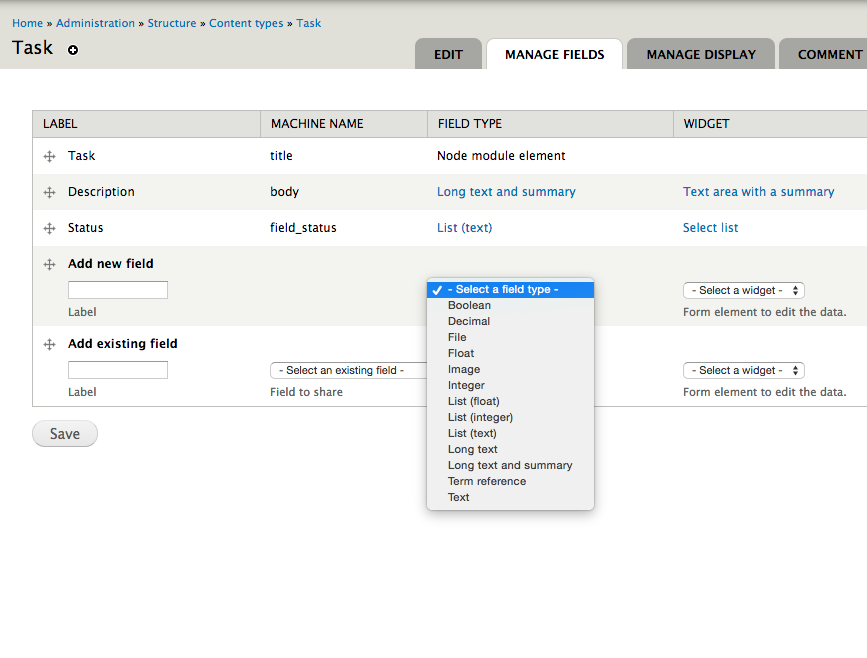
PANIC!!!!!!
Just kidding
WHat's next on the list
Does Drupal Core do this?If not, can I configure it to do this?- If not, can I download a module?
- Well, time to write code...
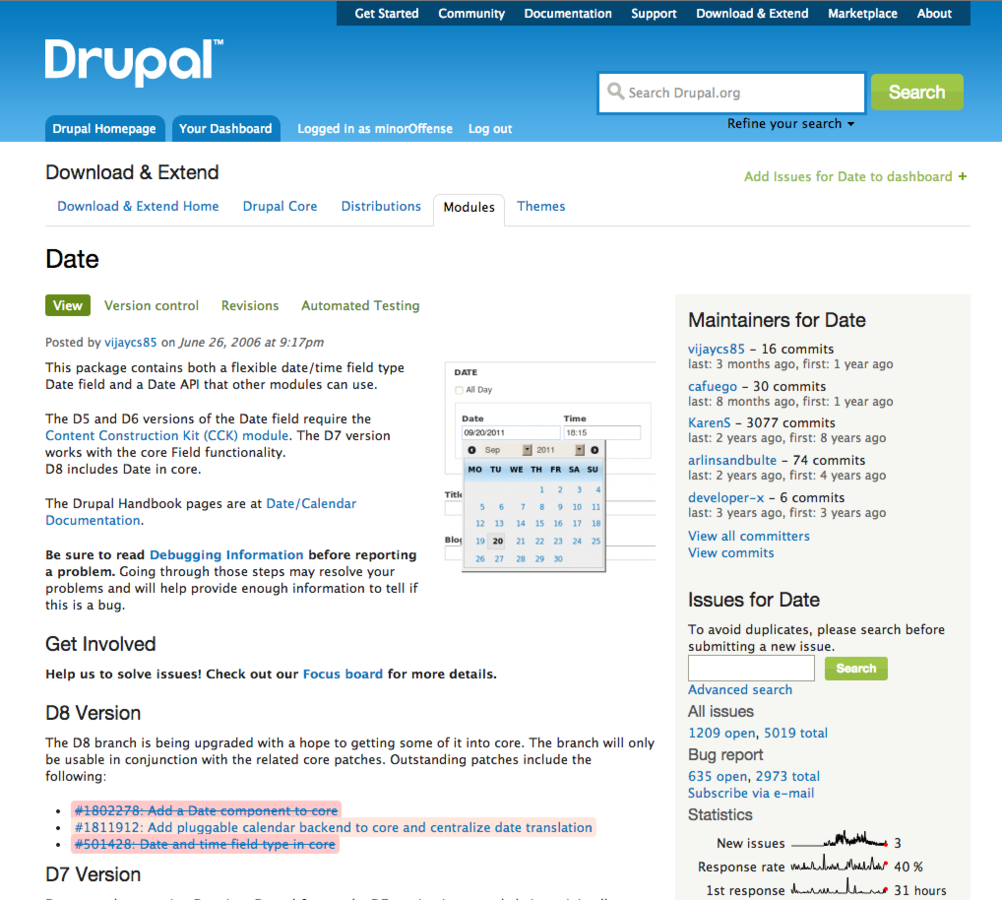
Ok, that's a lot of options...
Some modules come with "sub modules" which break up functionality into parts. That way you can turn on only what you need.
In our case, we just want the "Date" module itself.
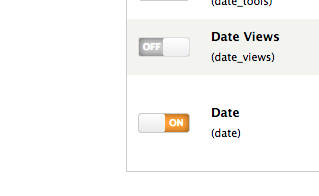
Yeah that one.
Some modules required what now?!
Certain modules require other modules to work. Most of the time modules take care of turning on the ones they need.
Click "Continue"
Helpful Messages
Lastly, sometimes when you enable modules, they give you hints on how to set them up or use them.
Watch for messages at the top of the page after enabling modules.
Get back to Manage Fields
Let's check the list of field types again.
You should see the "Date" option now.
Ignore the other date options. You'll likely never use them.
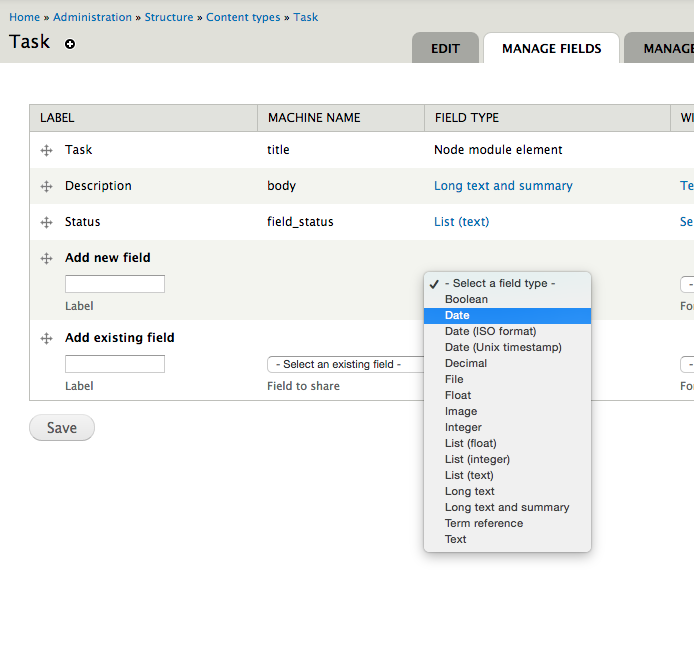
Date Field Settings
Let's set the date granularity and some global settings.
Use the site's timezone.
Turn on cache dates, leave the default settings for that.
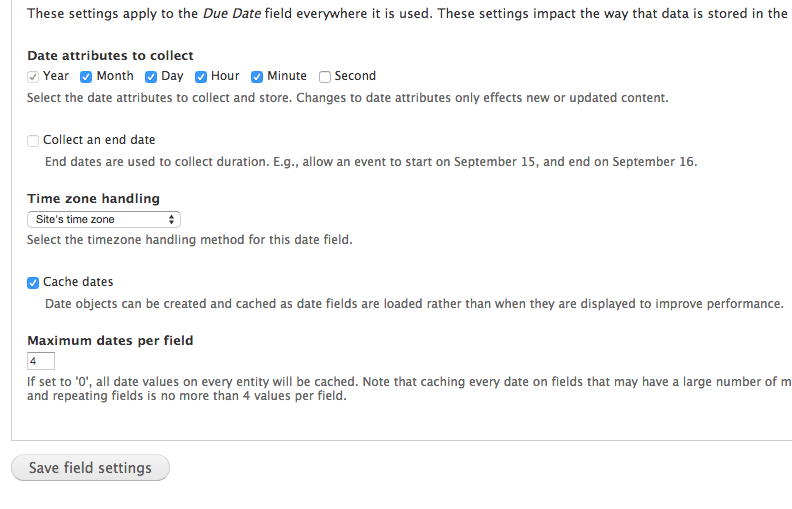
Date Field Instance Settings
Here we setup how users can enter dates.
Choose your date format, starting year, ending year, default date, etc...
Set these settings to whatever you think is right.
Save when you're done
Break Time
- Always save your work
- Commit your changes
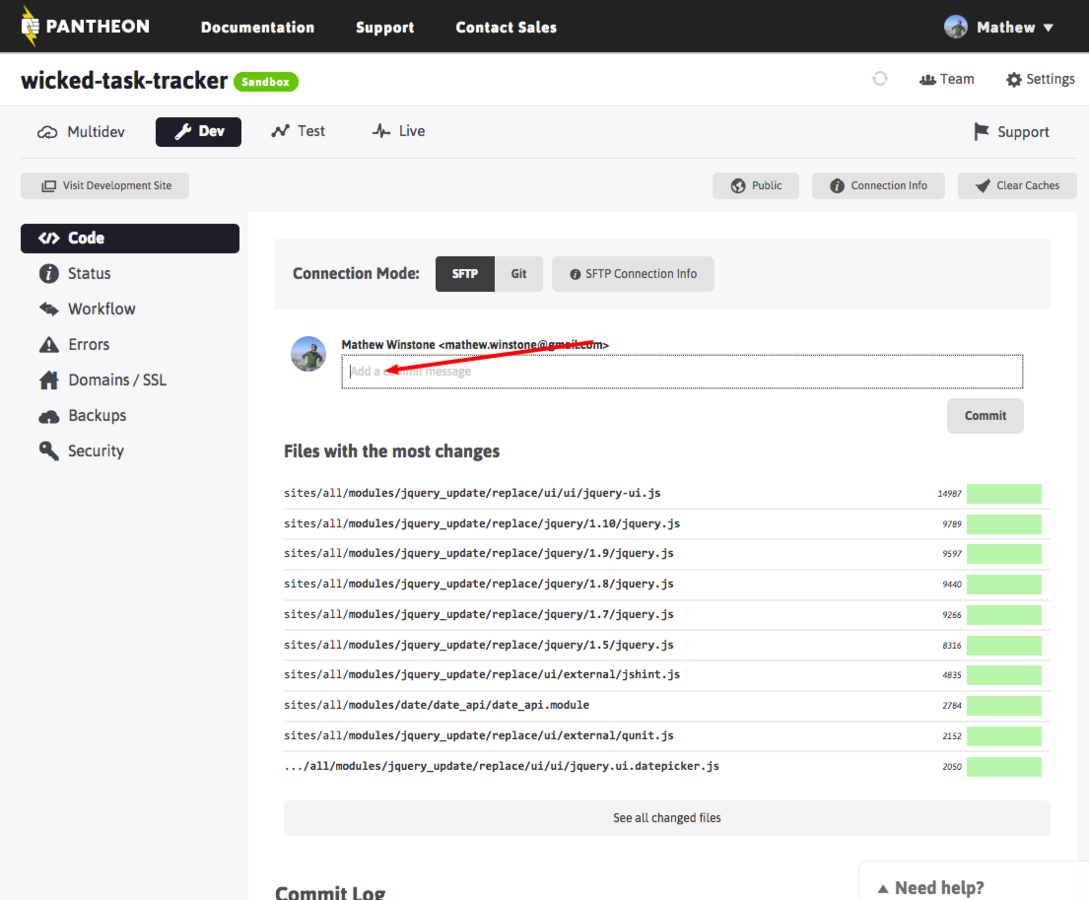
Use the Pantheon Dashboard to save your work
Achievment Unlocked
First Commit
View Modes
View Modes
A view mode is a way to render a single piece of content.
For example, the Article content type has two view modes; default and teaser.
Teaser is the shorter view you see on the homepage.
Default is the full page view with the comment form and all that when you view the article itself.
We can create / use view modes with our Task content as well.
Manage Display
On your content type page, click on the "Manage Display" link.
This will let you control how your fields show up based on the View Mode.
List of available View Modes
The list of enabled view modes for your content type are listed in the tabs at the top right.
Test Task
Let's create a Task and adjust the View modes until we get it displaying the way we want.
Go to "Content" then "Add Content". Click on "Add Task".
Create a task called "Put task information side-by-side"
Fill in a description.
Set a due date.
In the publishing options, Promote to Front Page.
Change Field Display Order
The simplest thing you can do is change the order of your fields.
Drag them around, click save and check out the change on your task.
Try putting date above description.
Try hiding the description in the Teaser view mode

Change the date format to be different in Teaser vs Default (hint: use the gear next to the date field)
Is that all I can do?
Yup. Unless we install a module.
WHat's next on the list
Does Drupal Core do this?If not, can I configure it to do this?- If not, can I download a module?
- Well, time to write code...
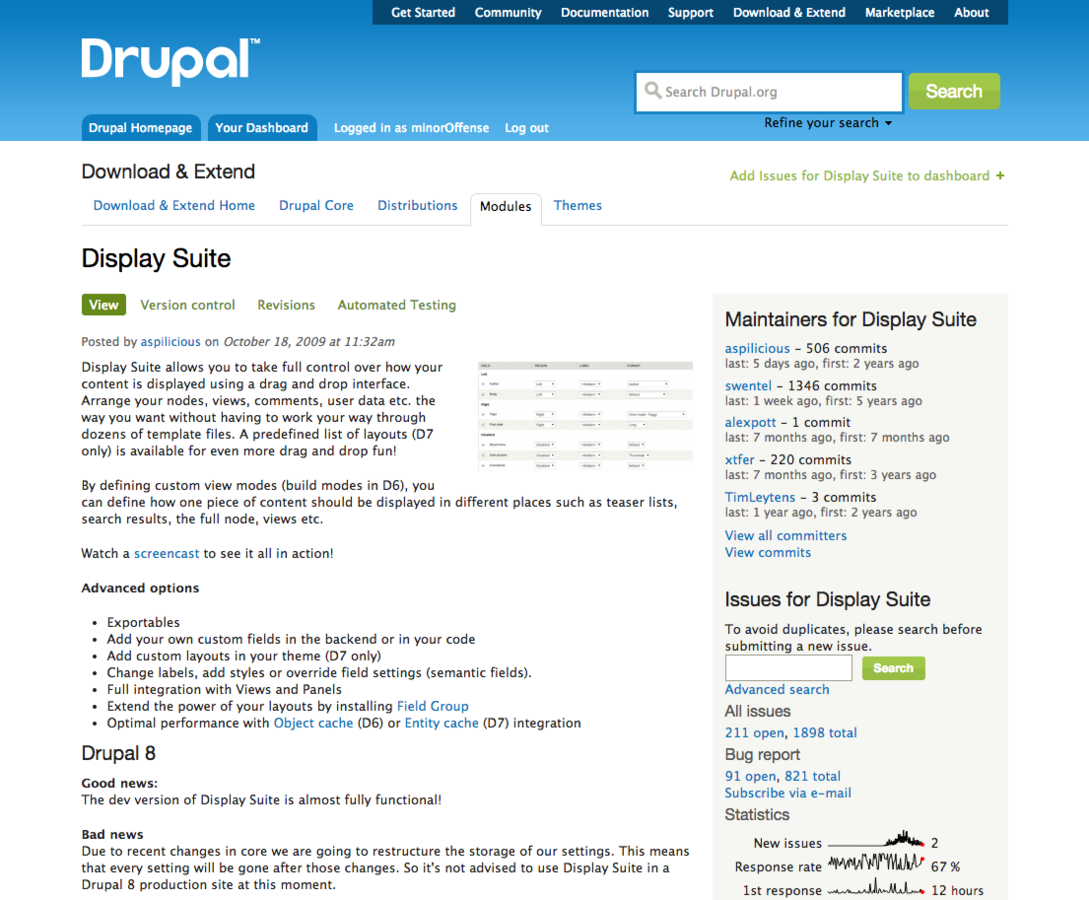
Display Suite
This module adds more controls and options to your "Manage Display" page.
Most importantly, it lets you select other layouts other than the standard single column we've been using.
Install and Enable Display Suite
That's right. You're on your own this time. Find the download link, add the module and enable "Display Suite UI" on your site.
I'll wait...
Done yet?
Everyone's waiting... :-P
I'm just teasing. Take your time and do it right.
Achievement Unlocked
New Construction Options
Select a Layout for Teaser
Go back to Manage Display.
Go to the Teaser view mode.
Select the Fluid Two Column stacked layout.
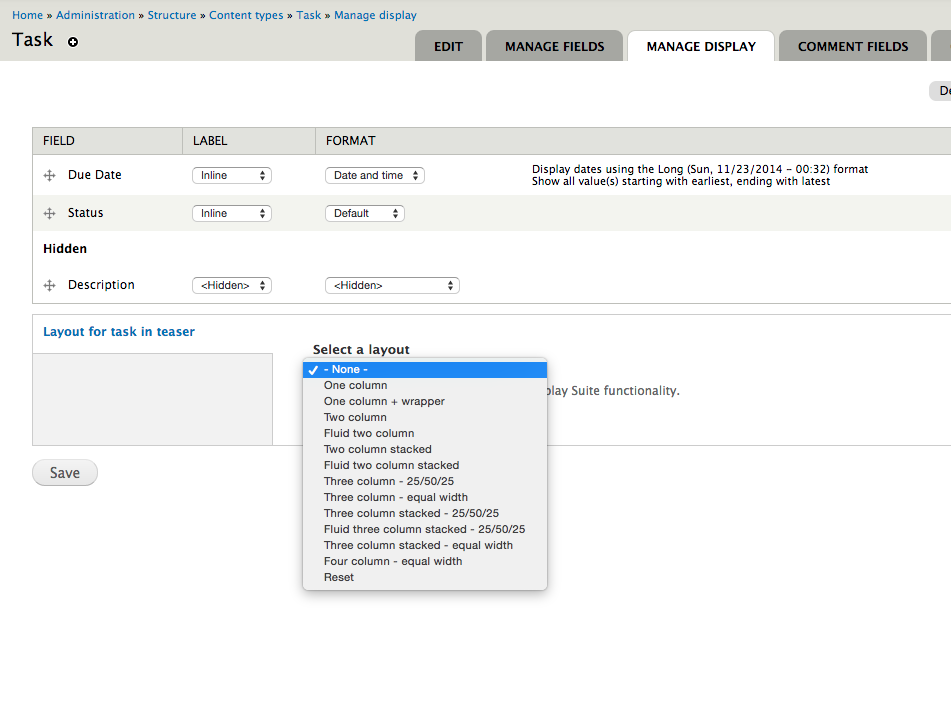
Organize your Fields
You'll notice you have a lot more options now. Display Suite also let's you control non-field items like the content post date, the author, and other stuff.
Place your items in the left or right column as you like.
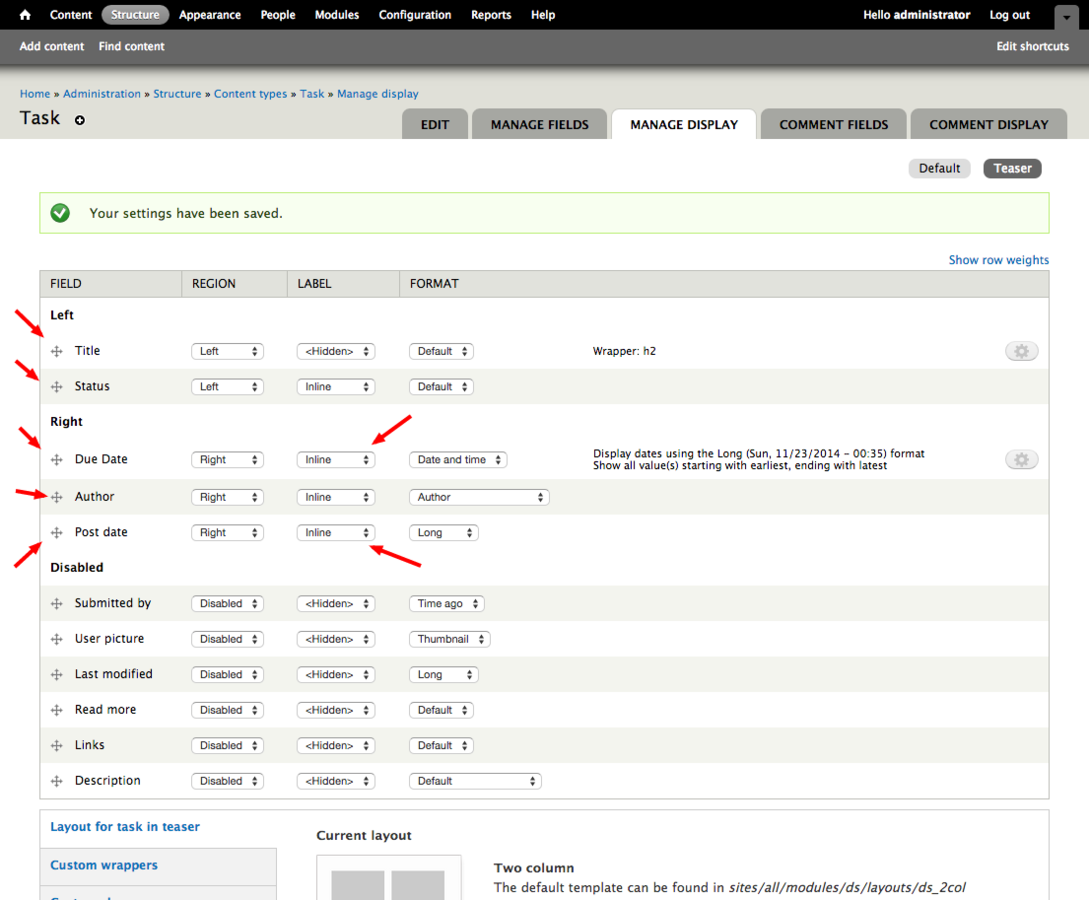
Titles and DS
Display Suite also lets you move the Title around. It also however defaults the title to not be a link.
Let's set the title to link to the content again.
Can we make this look nicer?
Sure can! Let's pick a new theme.
Install Bootstrap Theme
http://drupal.org/project/boostrap
Enabling Themes
You install themes the same way as modules, but you enable them on a different page.
Click on "Appearance" and you'll see Bootstrap listed.
Click on "Enable and set default"
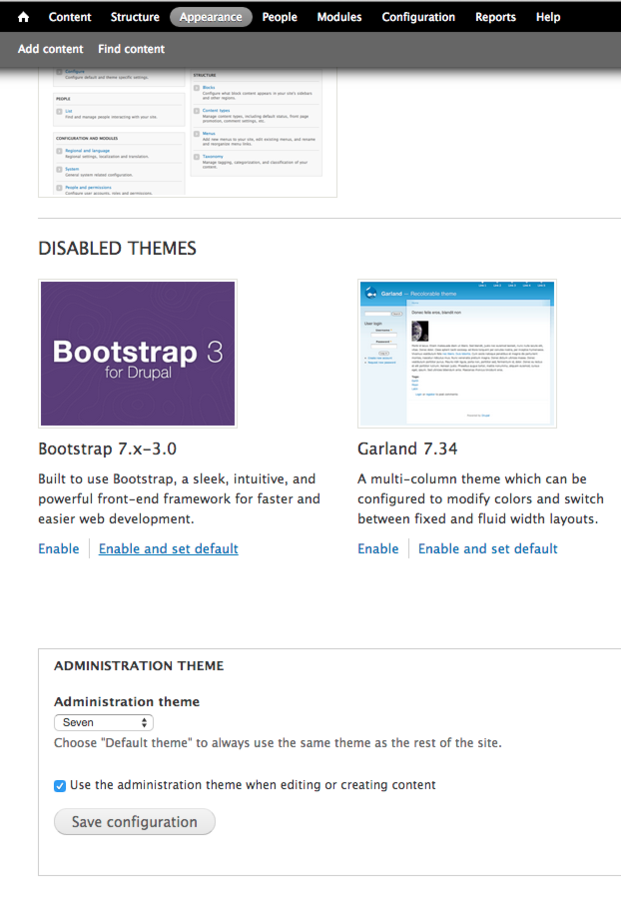
While we're here
Disable using the admin theme for content editing. Let people use the Bootstrap theme instead.
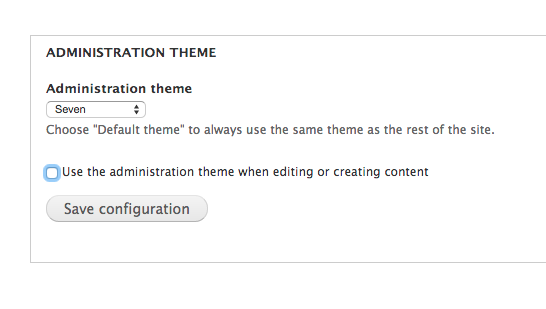
One more thing
jQuery Update
Bootstrap needs a newer version of jQuery to run than what Drupal comes with.
Thankfully, there's a module for that.
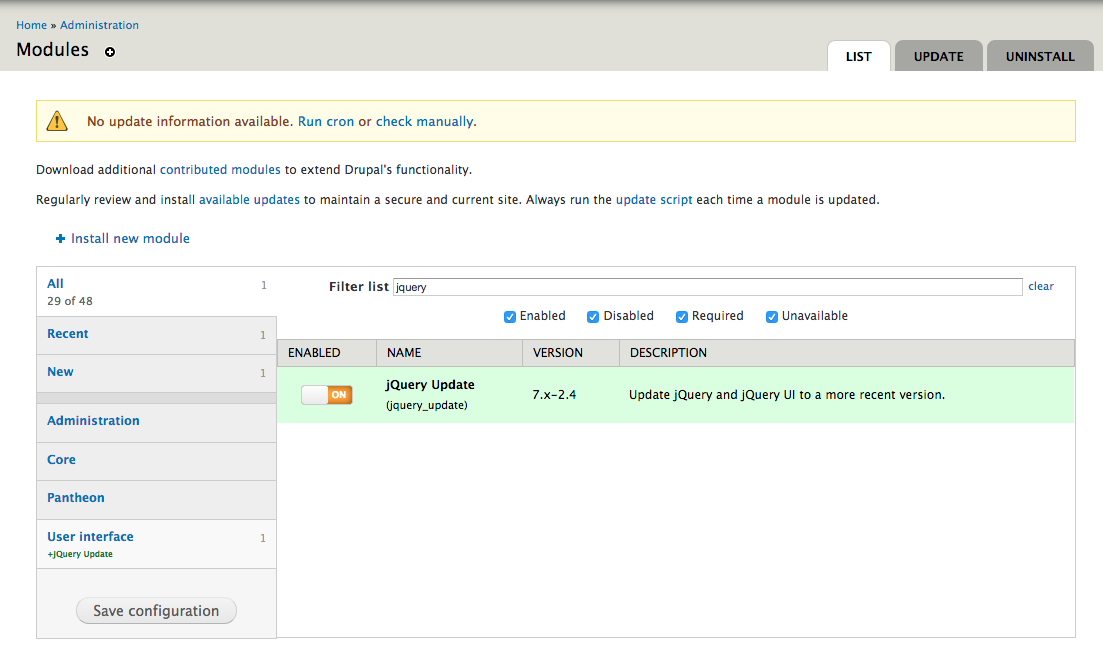
http://drupal.org/project/jquery_update
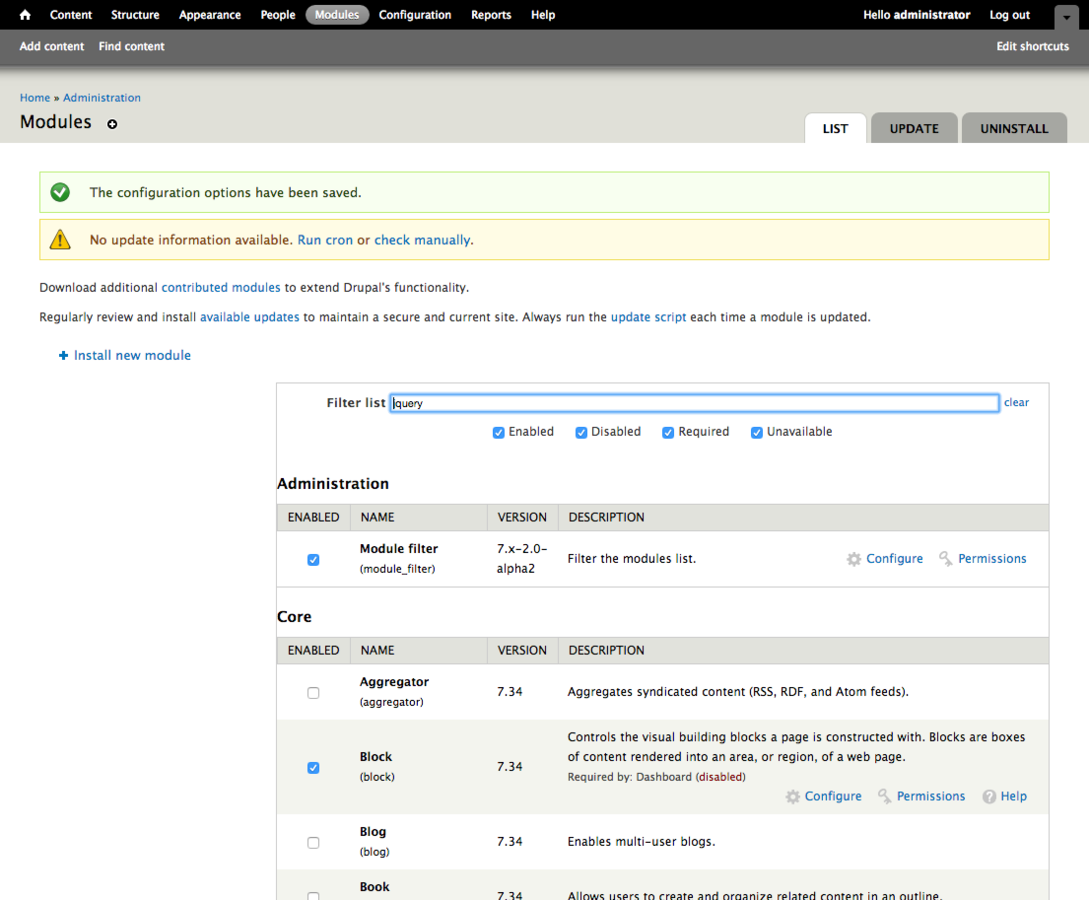
Oh no!
Configuration
Using the "Configuration" link, scroll down until you see "jQuery Update" in the "Development" settings section.
Configuration
The configuration section in Drupal is where you go to change most of the global settings for your site.
Each configuration group contains the core settings as well as any module specific settings.
When you setup a Drupal site, odds are you'll visit this page a lot in the beginning.
But once everything is up and running in production, you probably won't (or shouldn't) change stuff here unless you have to.
jQuery Update Settings
Leave the "Default" jQuery version at the latest version.
Change the "alternate" version to be 1.5
This will let your administrative modules work properly.
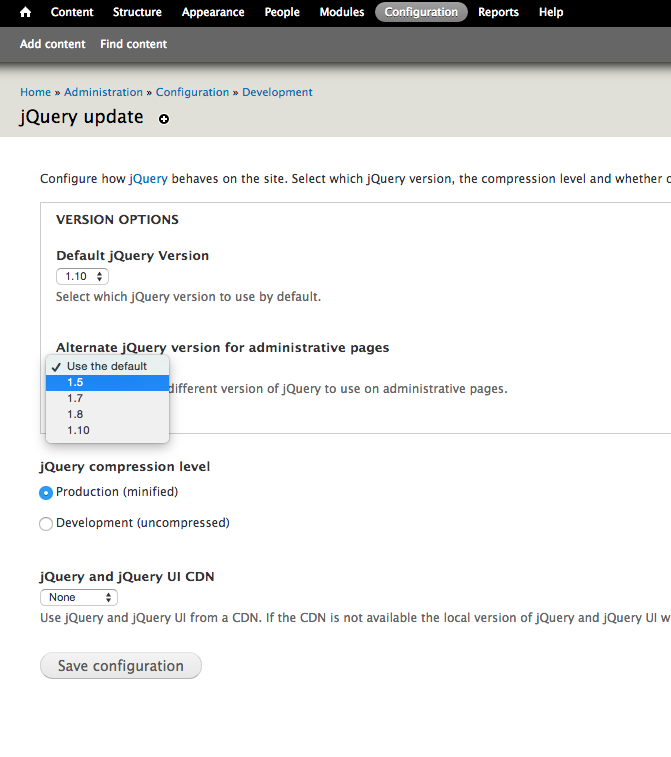
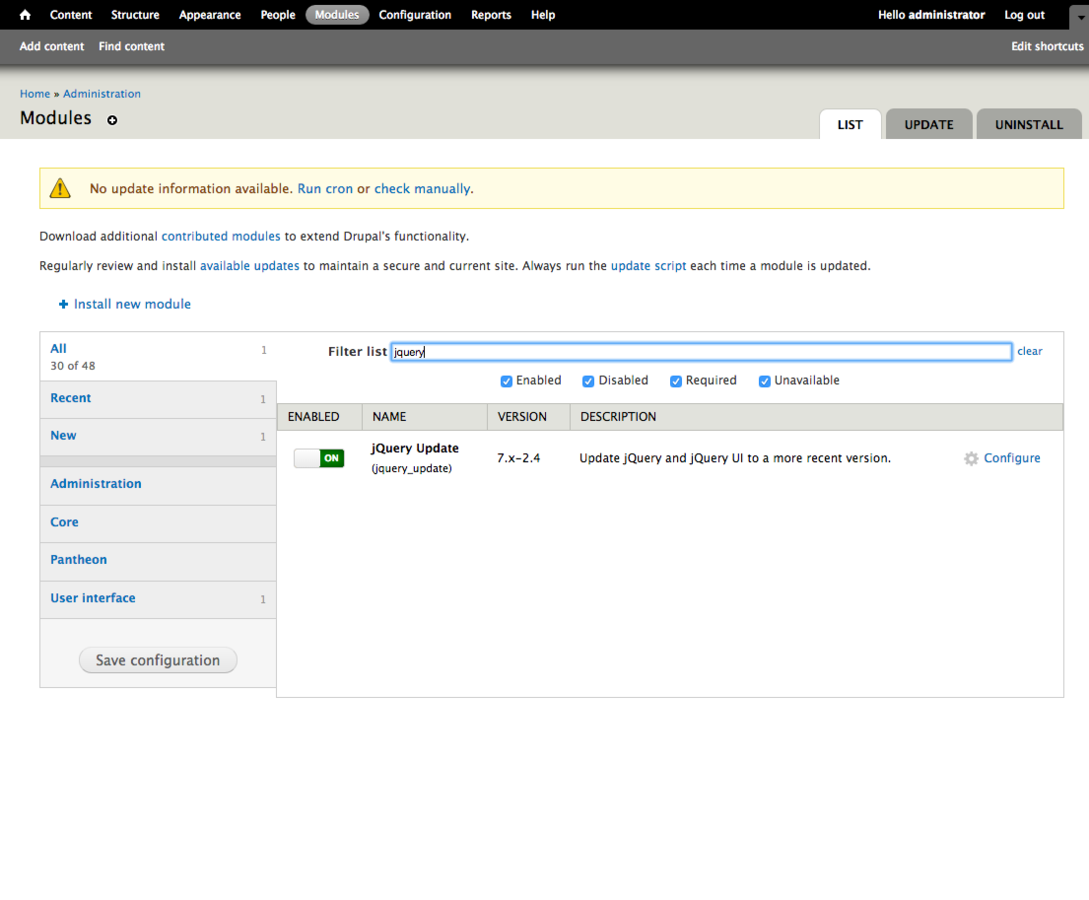
OH yeah!
Edit your Task
Give a try at editing your task.
You should see the Bootstrap theme now instead of Bartik.
Add More Tasks
Add a task for "Create a task list"
Add a task for "Add a menu for creating tasks"
Add a task for "Link to my task list from the main menu"
Our Problem
Right now, the only way to get a list of our tasks is either by publishing them to the front page (which gets mixed in with other content) or using the admin/content page (which once again, has everything).
Can we solve with With Drupal
You should know what to ask yourself right now. And what the answer is...
We need a module.
Lunch
Round
Two
How do we create a list of stuff?
Check the list
Does Drupal Core do this?If not, can I configure it to do this?- If not, can I download a module?
- Well, time to write code...
Views
It's kind of a big deal...
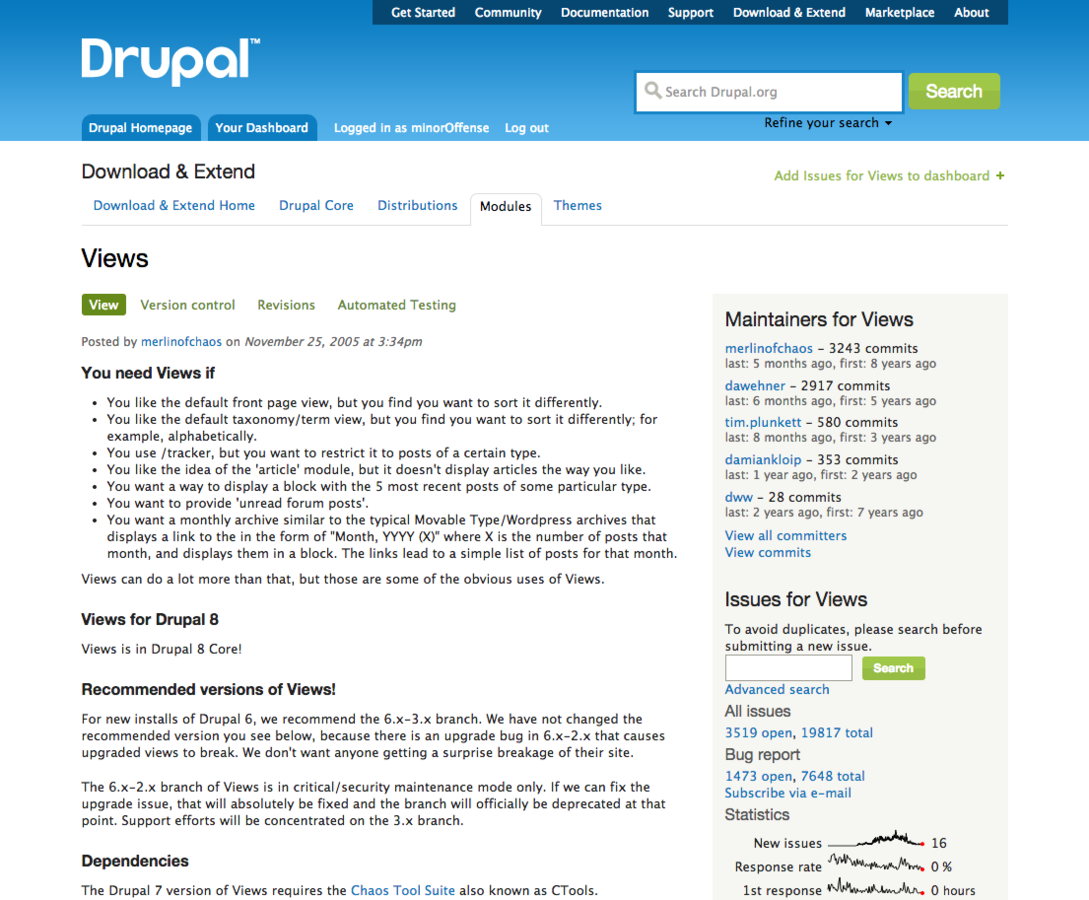
Install Views
Find the download link and add it to your Drupal site.
Enable Views
If you go to your Modules page, you'll see you can't turn Views one yet.
You have missing dependencies.
Google "drupal ctools" and find the module and add it.
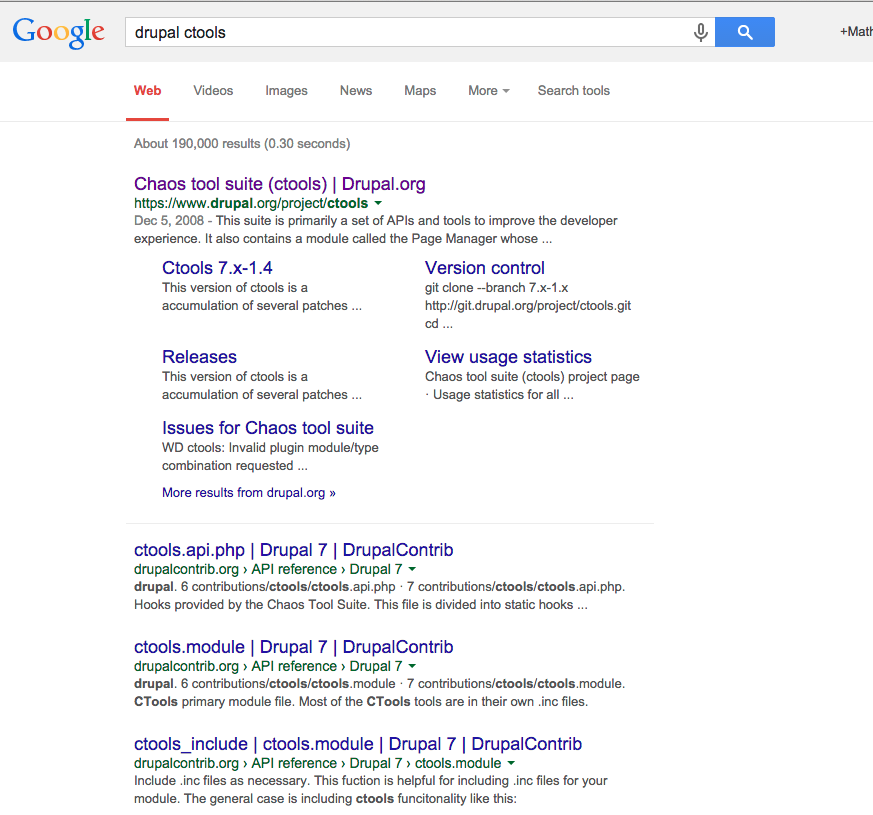
Google "drupal ctools"
Now Enable Views UI
Now that you've added Ctools, try to enable "Views UI"
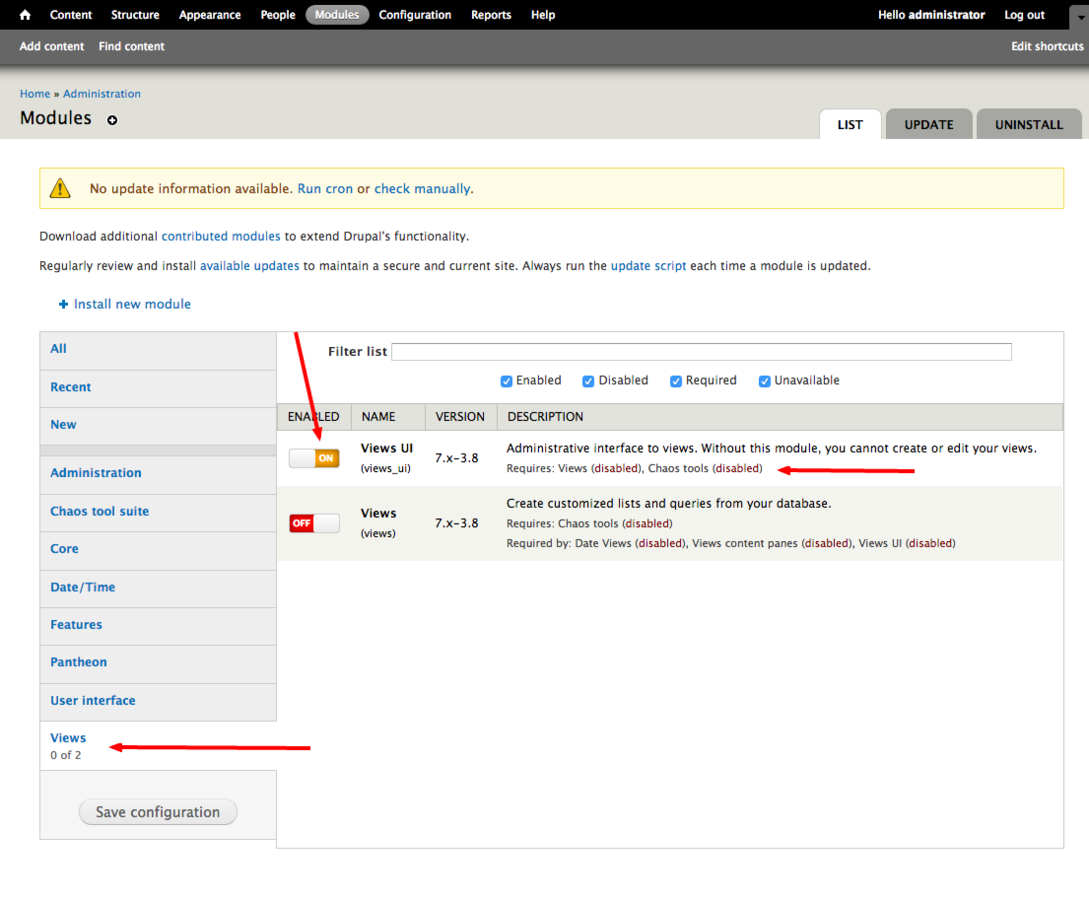
What are we doing with Views?
Views let's you do three very important things:
- Create a list of content
- Format the output of that content
- Embed that content anywhere on your site
Configure Views
After installing the module, click the "Configure" link.
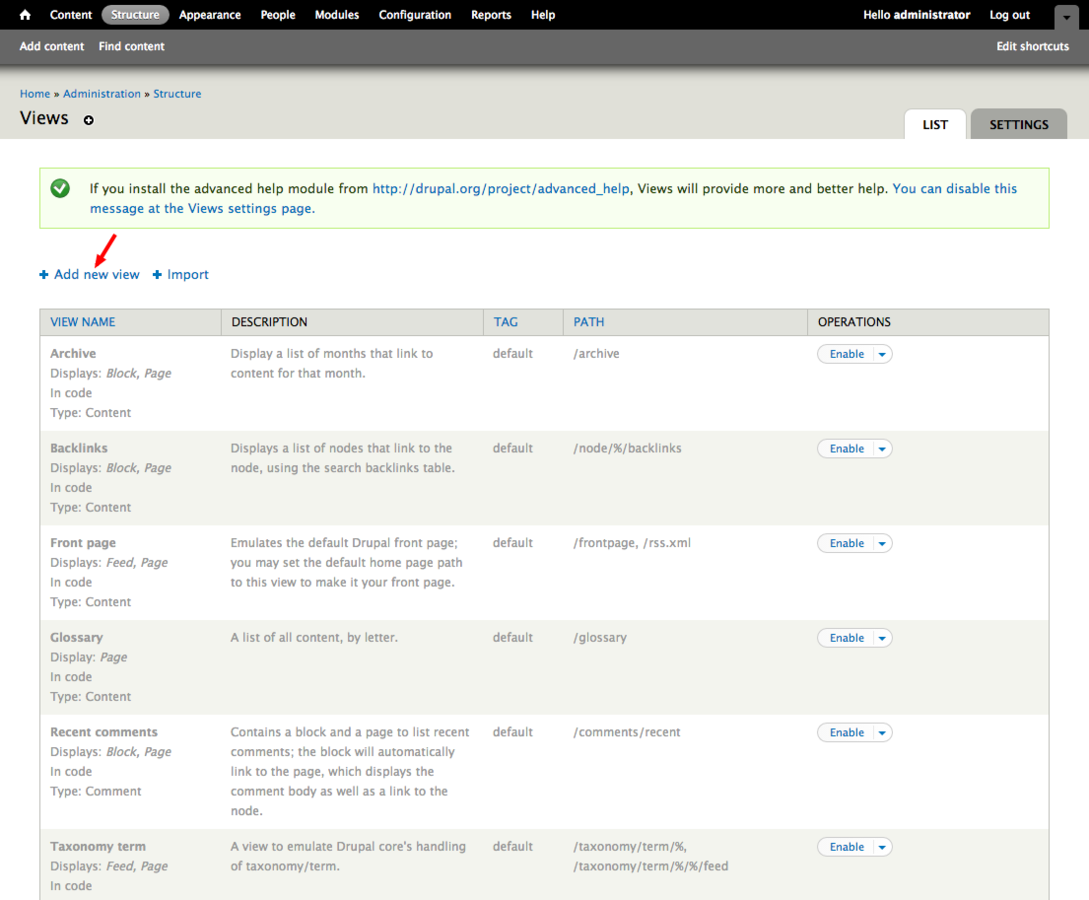
Add a new view
Make a Task List
Let's create a list of tasks.
Set the name to "Tasks"
Add a description
Show "Content" of type "Task" sorted by "Newest first"
Create a page at "/tasks"
Create a menu link in "Main Navigation" and "Use a Pager"
And you have a view!
Test it out
Open a new tab and go to "/tasks" on your site.
You should see a list of tasks.
Let's add some tasks to make our task list better!
- Make adding tasks faster
- Show how many tasks I have
- Allow images with tasks
- Make the tasks show their status
- Let me sort by due date
- Let filter by status
- Add a tab for "completed" tasks
- Filter out "completed" tasks
Faster Task Add
On the left hand side, under "Navigation", use the contextual links gear and select "List links"
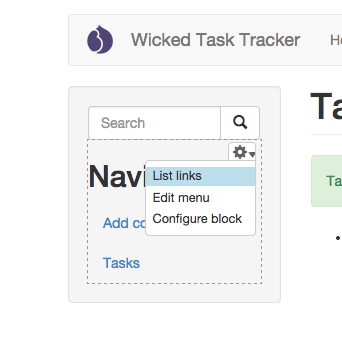
Set the Order
Change the order of the links. Put "Task" at the bottom.
Edit the "Task" link and rename it to "Add Task"
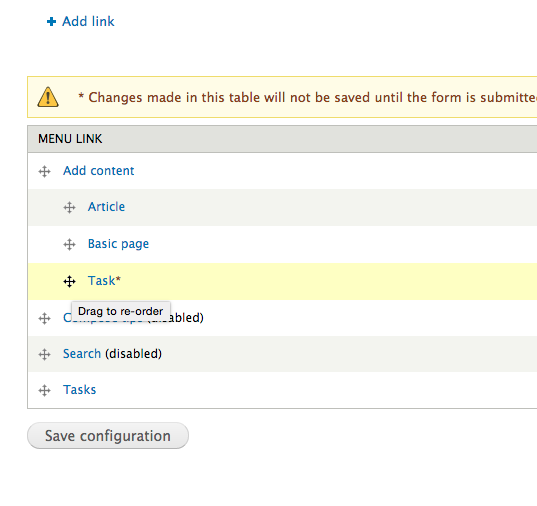
Go back to your Task list
Go back to /tasks
You can now in one click add a task.
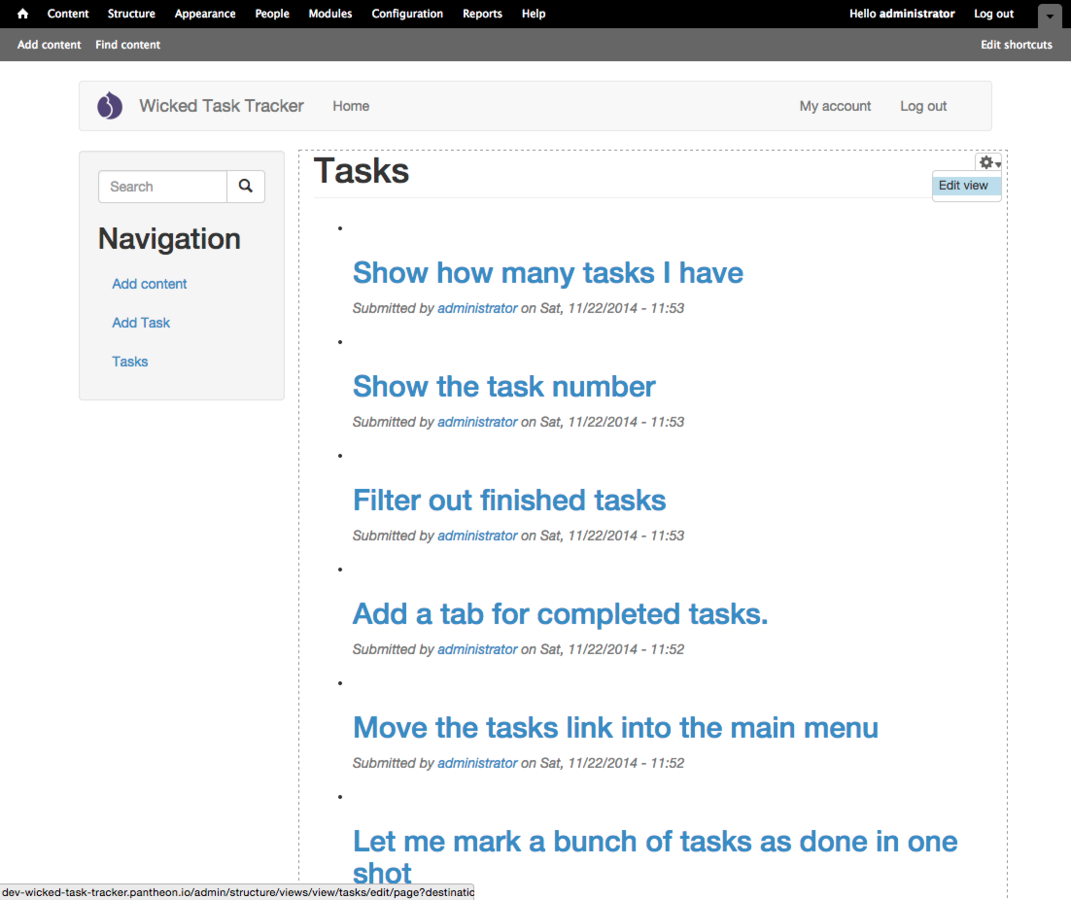
Todos
Make adding tasks fasterShow how many tasks I have- Allow images with tasks
- Make the tasks show their status
- Let me sort by due date
- Let filter by status
- Add a tab for "completed" tasks
- Filter out "completed" tasks
Add Count
Let's get Views to output the count of the results above the list.
Click on "Header" in the "Page Settings" section.
Header Options
The header settings allow you to add content above your Views.
Add a "Global: Result Summary" to the header.
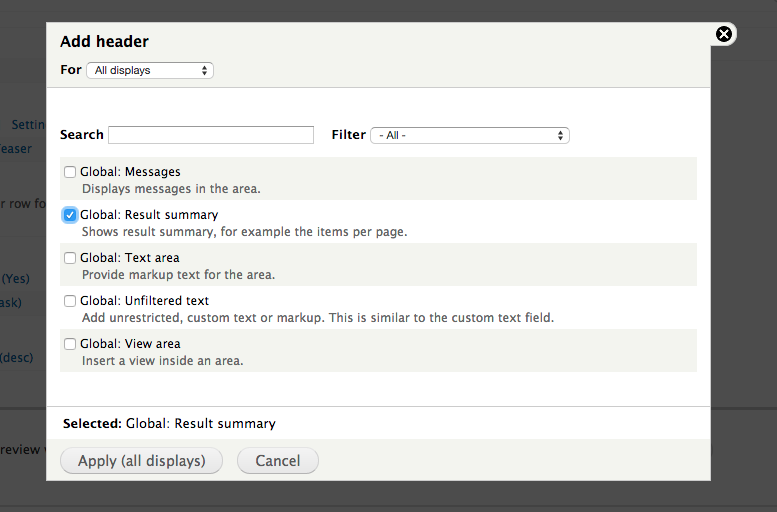
Customize the Text
You'll see some "tokens" in the text.
Tokens are special words which get replaced with information when the view is displayed.
Adjust the text as you like.
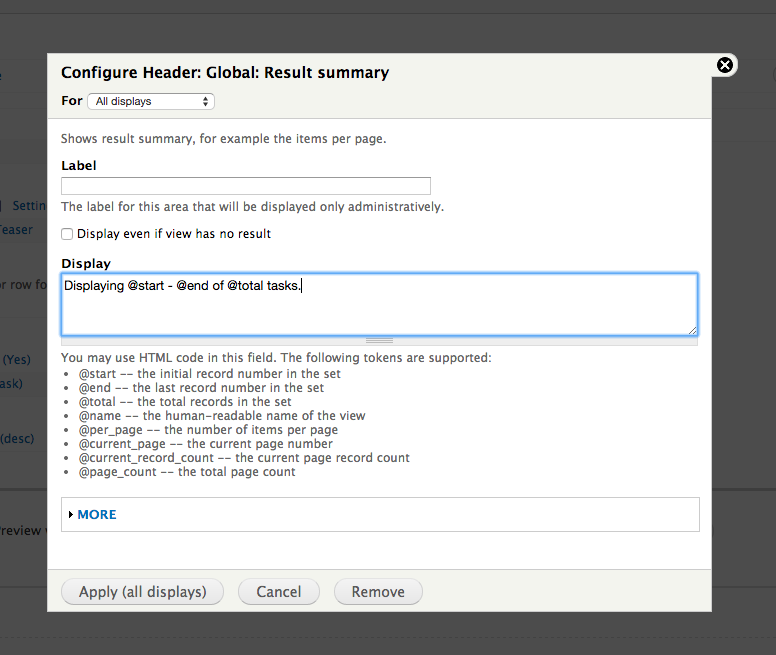
Save and Check out your Task List
You now have the count at the top of the page.
Mark that task as "completed".
Things are starting to come together.
What's next?
Add Images
Why shouldn't we be able to add images to tasks?
Let's go back to Manage Fields
Have a look at the existing image fields (i.e. field_image)
Does it meet our needs? (add the existing field and have a look at the settings)
Field Settings
- Instance Settings
- Global Settings
Pros
- No new fields need to be created
- Simple for users (e.g. limits can be freeing)
- Don't have to deal with displaying all the images together
Cons
- People may want more than one image
- People man end up creating more tasks to have more images
- Probably need some kind of gallery or slider to show them all together effectively
New Field Means New Display Options
Now that we have a new field, let's setup how we show it.
Go to Manage Display. Choose Teaser view.
Change the layout to "Three Column Fluid"
Configure Image DIsplay
Now that we have an image, let's make sure it gets sized right.
Put the image in the left hand column.
Edit the image field display settings (look for the gear)
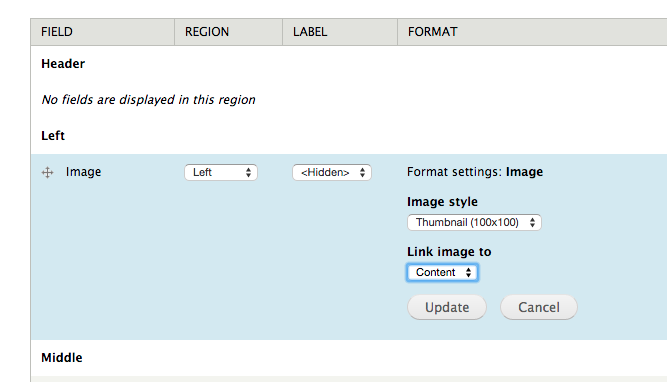
Set Image Style
Image Styles
Drupal can resize images automatically for you when they get displayed.
Settings for displaying images are called "Image Styles"
You can add or edit the existing image styles in the Configuration section.
Look for "Image Styles"
We'll create a new image style later. For now, use Thumbnail.
All said and done, your task display should look like this.
Achievement Unlcoked
Perty' Pictures
Todos
Make adding tasks fasterShow how many tasks I haveAllow images with tasksMake the tasks show their status- Let me sort by due date
- Let filter by status
- Add a tab for "completed" tasks
- Filter out "completed" tasks
Go Back to your Task List
Use the gear to edit the Task List view.
Sort Criteria
Click "Add" under sort criteria.
Look for "Due Date"
Check the box, click Add.

Add Due Date
Exposed Sorts
Sort criteria in Views can be exposed to the user. That let's the user choose how to sort things.
Check off "Expose this sort..."
Set the default sort to "Ascending"
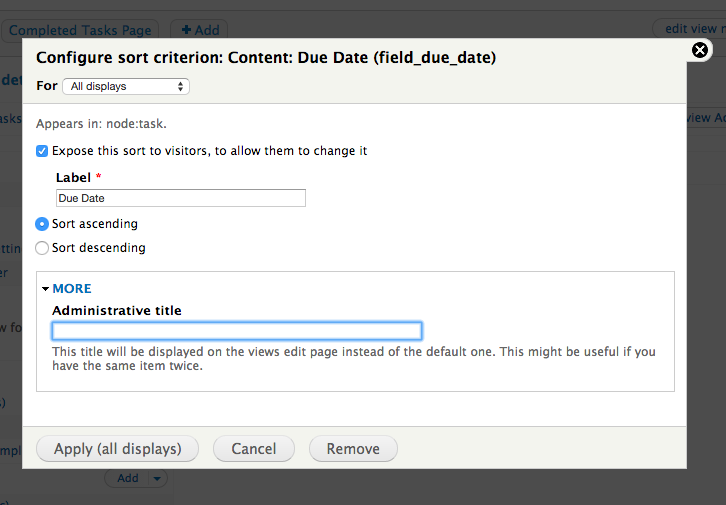
Save your View and voilà
Todos
Make adding tasks fasterShow how many tasks I haveAllow images with tasksMake the tasks show their statusLet me sort by due date- Let filter by status
- Add a tab for "completed" tasks
- Filter out "completed" tasks
Edit your View
In the "Filters" section, Add the "Status" field.
Filters can be exposed just like sorts.
Expose this filter, let people choose their status options.
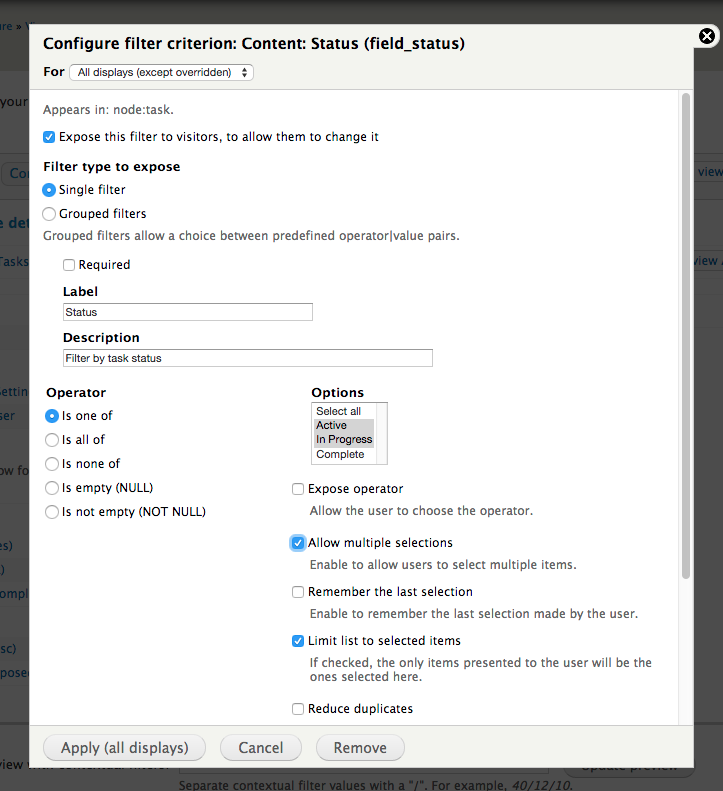
Save your view and BAM! Filter by status. Getting the hang of things?
Todos
Make adding tasks fasterShow how many tasks I haveAllow images with tasksMake the tasks show their statusLet me sort by due dateLet filter by status- Add a tab for "completed" tasks
- Filter out "completed" tasks
Views Displays
You can reuse a configured View to show the same (or very similar) list of content in different ways.
We'll add a display specifically for Completed tasks.
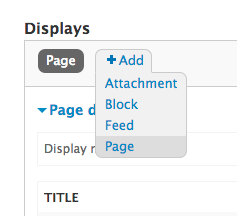
Add a new Page Display
Lots of stuff to setup...
Setting up a new Page display
- Change the Display Name
- Change the Page Title
- Change the Menu Path
- Change the list of content
Views Displays
Views displays by inherit settings from the default display.
If we want to make changes that only affect this display, we need to make sure we always set...
Apply
This
Display
Display Name
The Admin Title is already set for this display, so no button required.
Look for the "Display Name" section.
The Display Name is only used by administrators. Users won't see this.
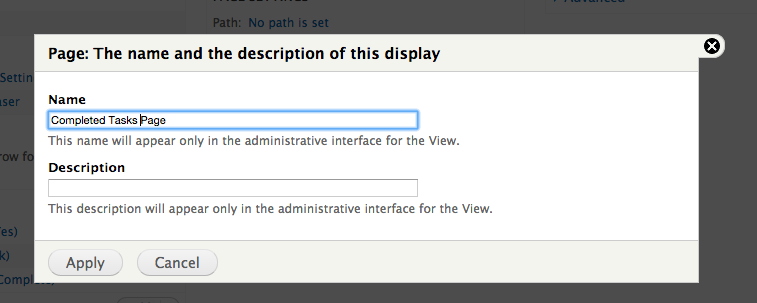
Title
Now we're getting into overriding settings. Click on the "Title".
Select "This display (override)" in the select box.
Change the title to "Completed Tasks"
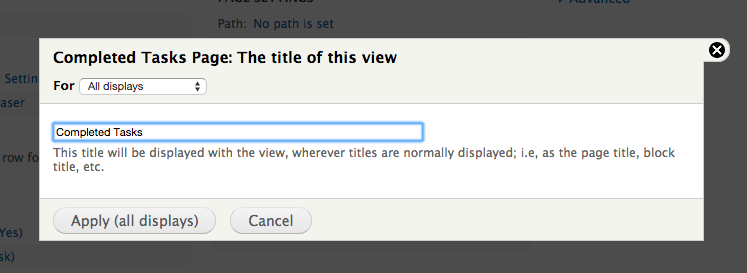
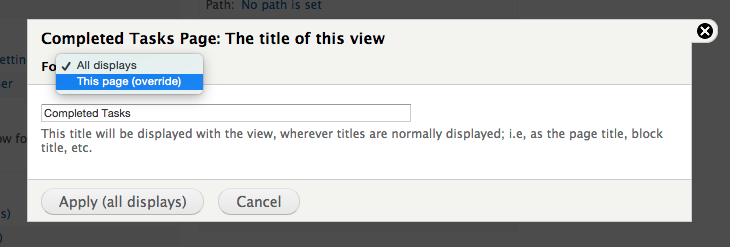

Overridden settings appear italicized
Change the Filter Settings
Instead of exposing the "status" filter, we'll fix it to "completed"
Set to "This page (override)"
Edit the "Status" filter, uncheck "Expose".
Set to "Complete" and "Is one of".
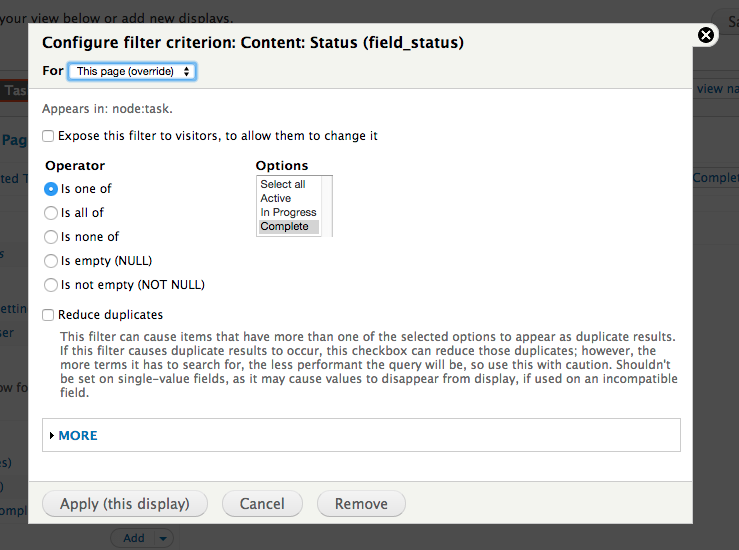
Set the Path
This setting doesn't need to be overridden.
Change the path to "tasks/completed"
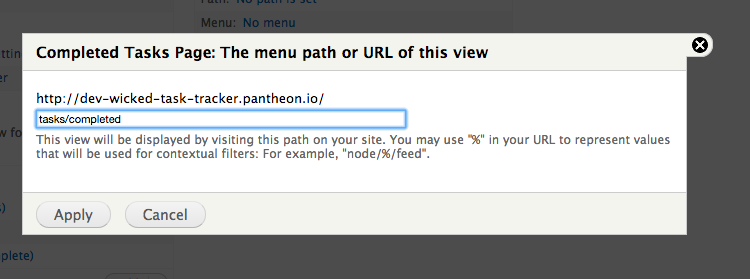
Check the Preview at the Bottom. Save if it looks good.
Go to "tasks/completed".
Almost there, but we're missing the tab.
Edit the View, Click on Menu Settings
Select "Menu Tab"
Set the title to "Completed"
Choose "Main Menu" under "Menu"
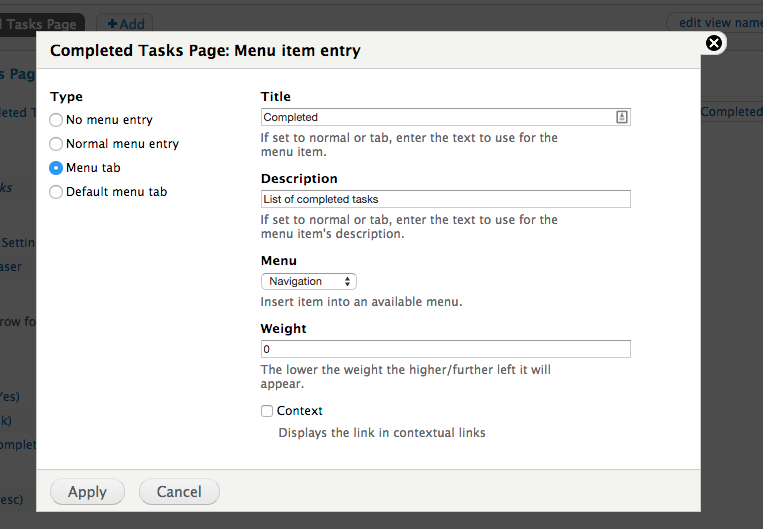
(This image shows "Navigation", don't do that...)
One down...
We've setup the "Completed" page to show up as a tab.
Now we need to change the main "Task" list display as well.
The main task display is our "Default menu tab"
Menus are weird
Drupal's menus are kind of weird. Follow along and don't be afraid to ask questions.
Switch to the Task List Display
Edit Path settings
Change to "tasks/list"
Edit the Menu settings
Change it to "Default Menu Tab"
Set the title to "Tasks"
Set Menu to "Main Menu"
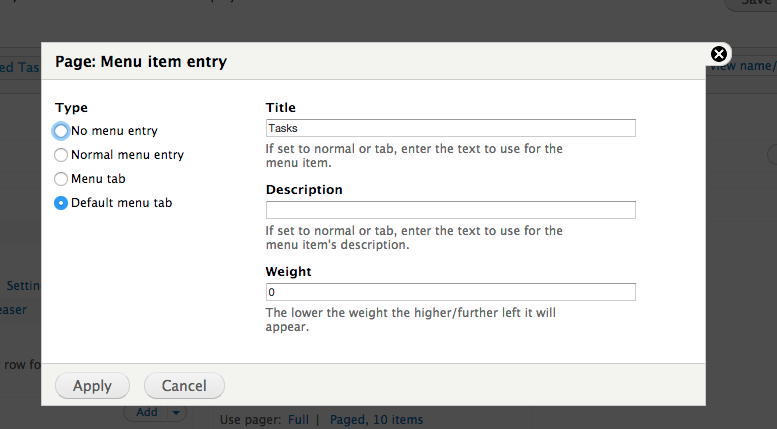
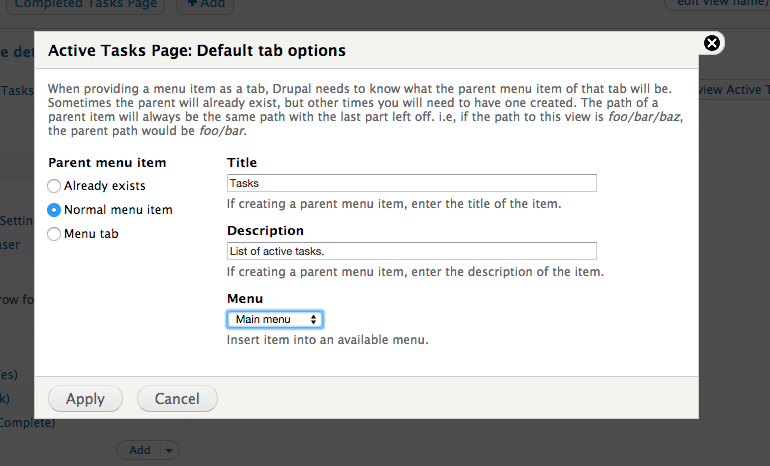
Save and you should have tabs
(It's ok if you don't, menus are weird)
Todos
Make adding tasks fasterShow how many tasks I haveAllow images with tasksMake the tasks show their statusLet me sort by due dateLet filter by statusAdd a tab for "completed" tasks- Filter out "completed" tasks
Quick Review
Added a Views Display
Added menu items
Added filters
Added sorts
Achievement Unlocked
Wizard with Views
Bonus Round
Not for the light hearted
Configuration
Let's go over the Drupal configuration pages
Account settings
Content Authoring
Media
Search and Metadata
Regional and Language
System
User Interface
Development
Web Services
People, Roles and Permissions
Reports
Structure
Content
Appearance
Modules
Allow Bulk Task Changes
Instead of having to update your tasks one at a time, why not update a bunch at once?
Add two new modules
Views Bulk Operations
Entity API
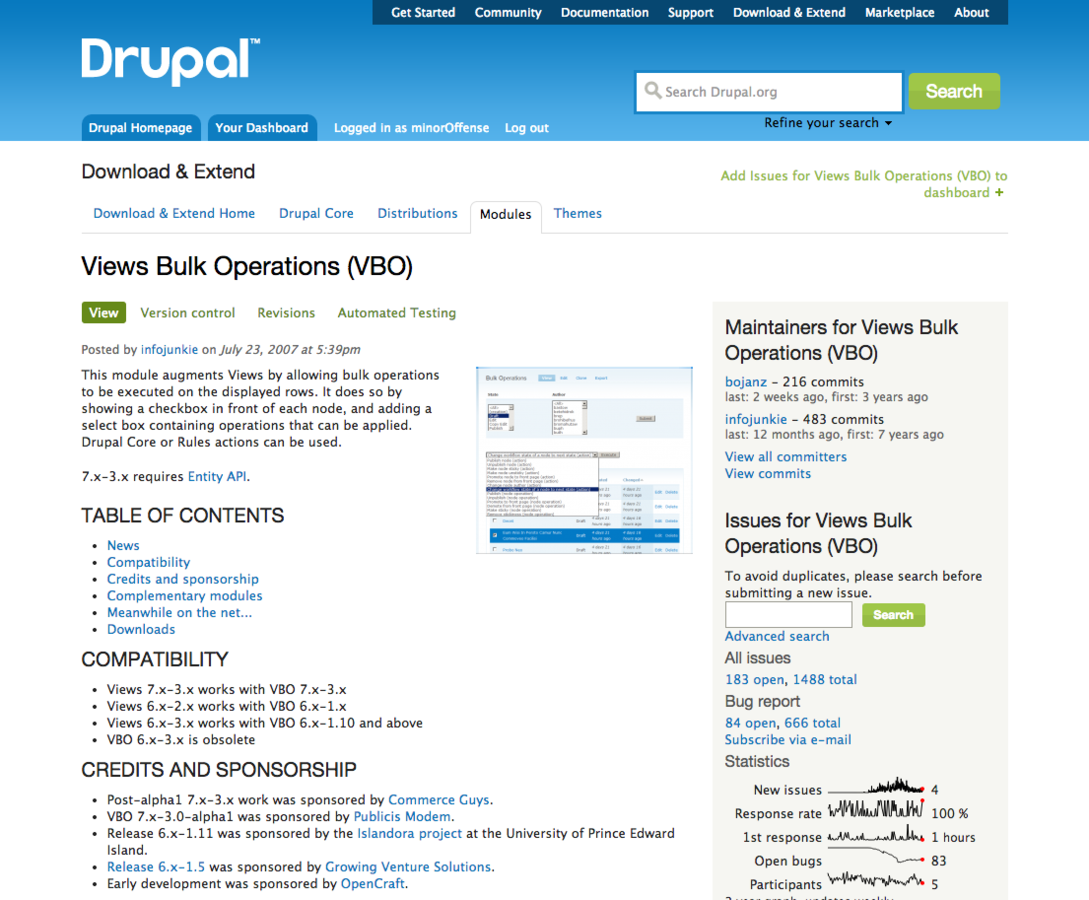
Views Bulk Operations
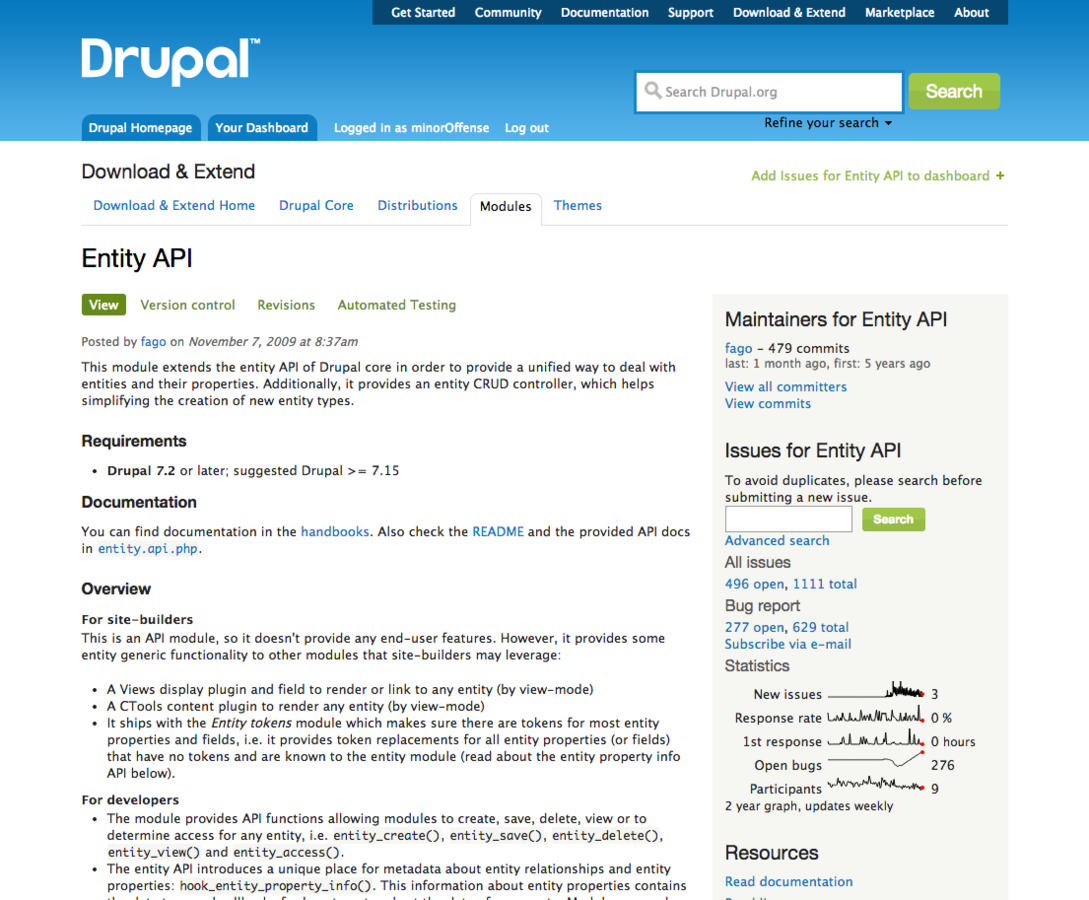
Entity API
Enable Views Bulk Operations
Edit Task View
Change the "Format" from "Content" to "Fields"
Gives us more granular control over the displayed content in Views.
We'll add the "Bulk Operations" checkbox for each task.
Change to Fields
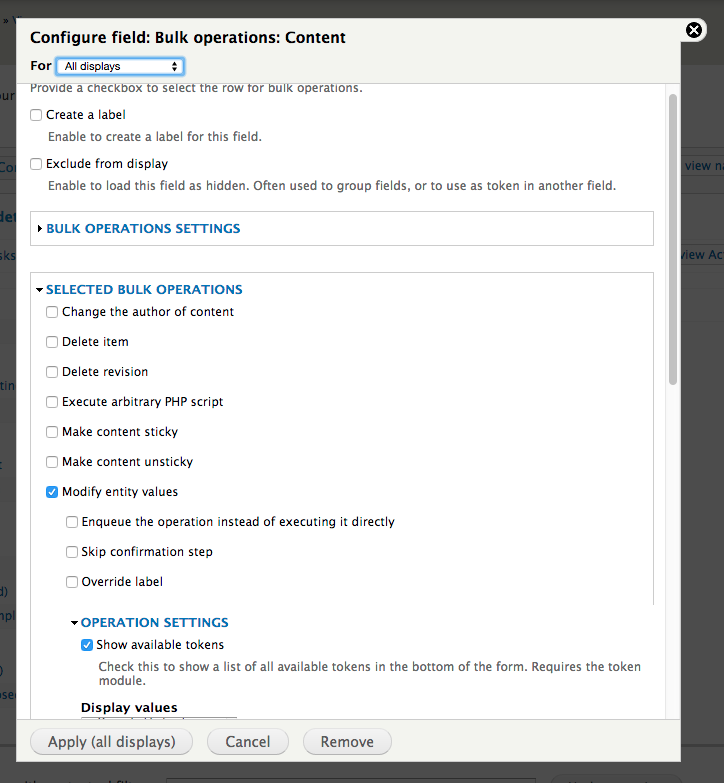
Click "Add Field" and choose "Bulk Operations: Content"
We want to "Modify" the Tasks in Bulk
Choose "Modify Entity Values" in the list of options.
Select the "Fields" you want to be able to update (ex: Status, Due Date)

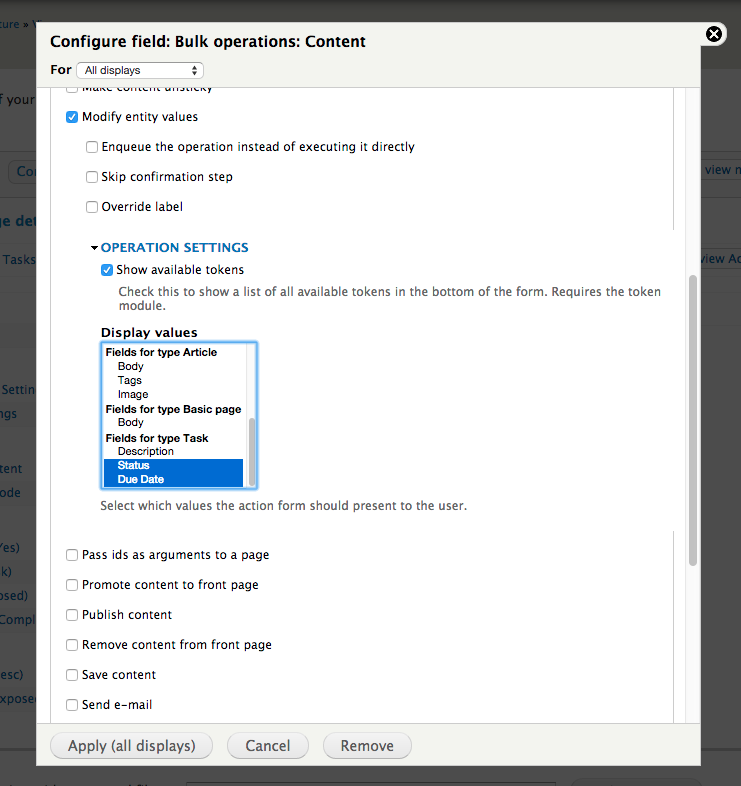
Choose your modifiable values
Add "Rendered Node" field
We'll get views to also display our task in "Teaser" mode.
Click "Add Field"
Choose "Rendered Content"
Set Display to "Show complete entity"
Set View Mode to "Teaser"

Clean stuff up
Change your HTML format to "Table" from "HTML list"
Reorder the fields to the right order.
(Use the arrow dropdown next to "Add" and choose "Rearrange")
Put the Bulk Operations first, rendered node second.
Check out your new Task List
Feel free to tinker with some settings.
Try out some options, see what you like.
Checkboxes and Updates
Achievement Unlocked
Bulking Up
Bonus Round #2
Entity Reference
What are Entities?
Entities are a higher level type of content.
Nodes are entities
Users are entities
Comments are entities
etc....
Why do I care?
We can reference any entity from another.
That means we can "Assign" a "User" to a "Task".
Or we can "reference" a "user" from a "node".
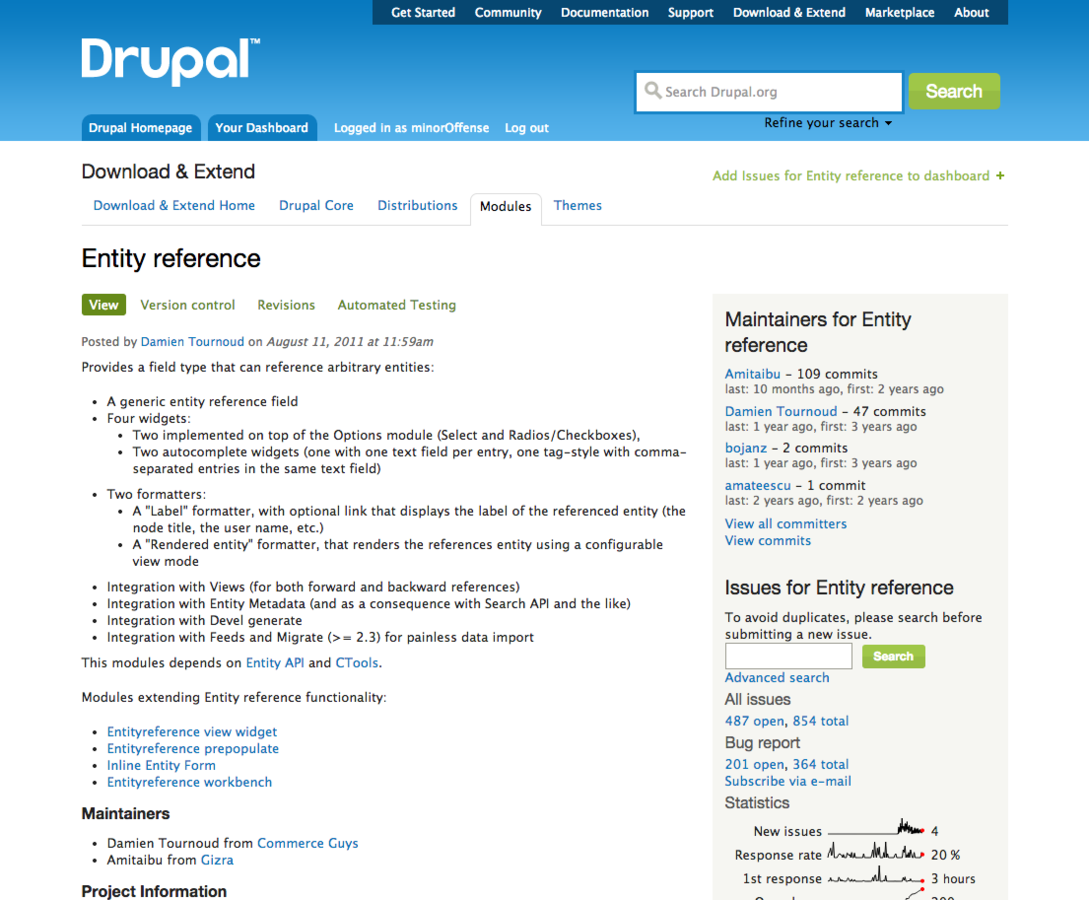
Manage Fields
Add a new field called "Assignee"
Select "Entity Reference" and set the widget to "Autocomplete"
Setup your field
Choose the "User" entity type.
Save settings
Instance Settings
Configure the field like any other.
Manage Display
New field means new display options.
Configure the reference to link to the user.
Drag it to a column you'd like.

Edit Some Tasks
Edit a task and assign it to your user.
What about other users?
You can create more user accounts.
Better yet, share a link to your site with a course mate. Have them create an account.
Generate Users
If you don't have anyone to sign up or share you site with, we can generate some users.
Generate Content
If you don't want to have to continue to create new tasks, we can have Drupal generate some dummy content.
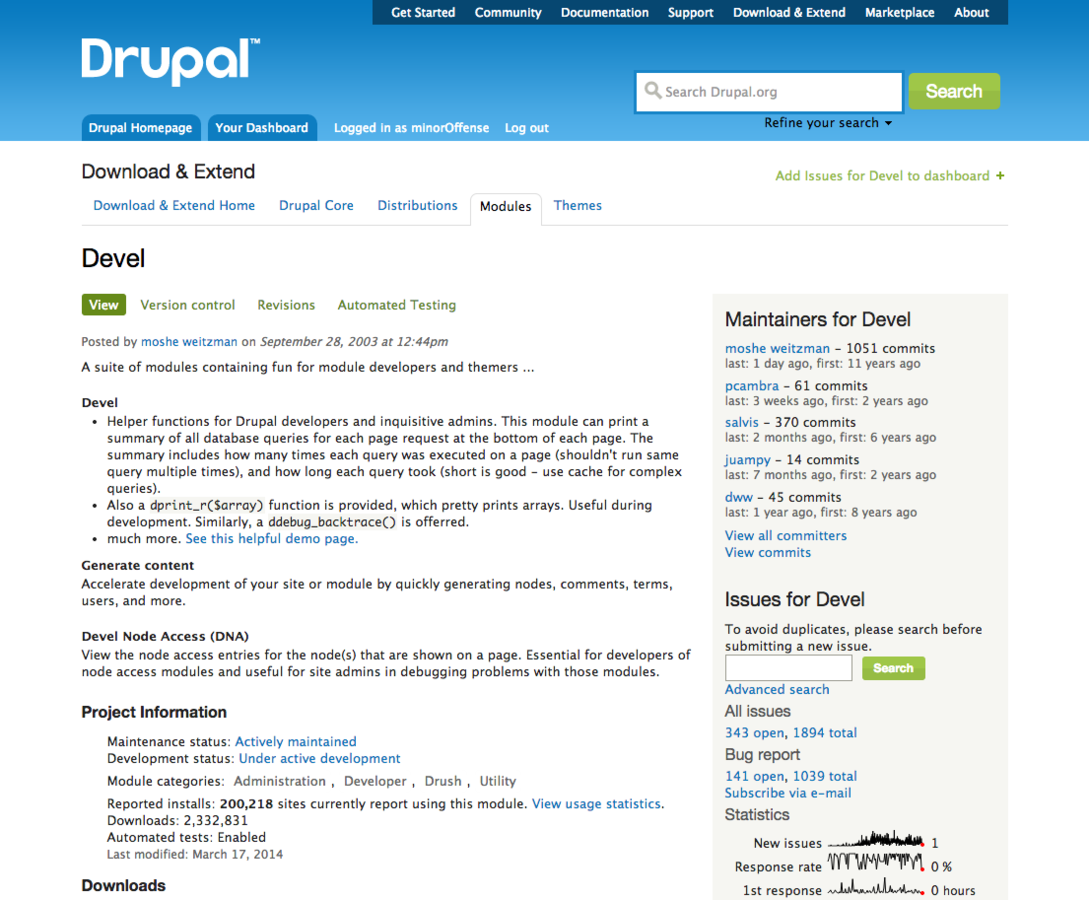
Enable "Devel Generate"
This module is strictly a development tool.
But it's super handy.
Configuration then Generate Users
Choose how many to create
Pretty simple list of options.
Create 10 users.
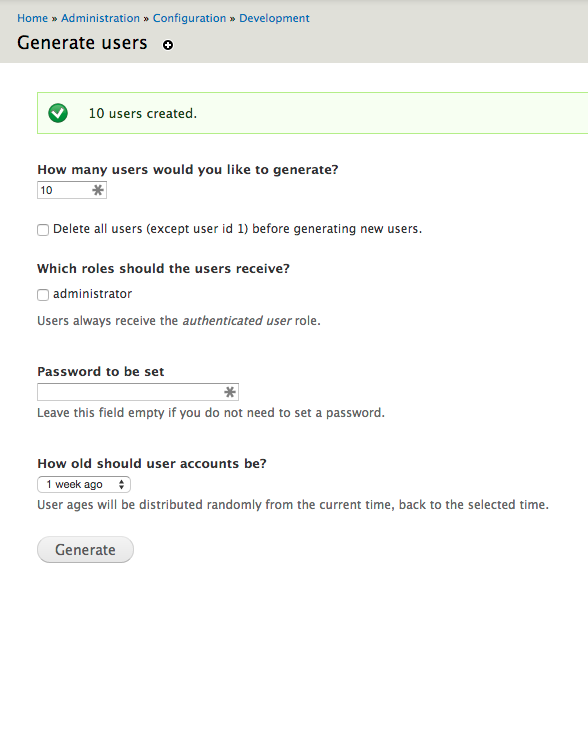
Generate Content
Similarly, you can generate content under the Configuration page.
Typically, you always want to generate users first since content needs a user, but a user doesn't need content.
Questions?
If we've reached this point, I'm sure there has to be some questions.
Thanks !
Extra Links
LLC Intro to Drupal
By tset
LLC Intro to Drupal
Learn how to build an awesome task manager web application with Drupal. No code required!
- 2,714



